#at least the gameplay improves later on fortunately
Explore tagged Tumblr posts
Note
bloody hell y4 on hard feels like a vacation after y3 on normal. i wanna know why y3 is so broken. what made rgg think fucking up the physics in bowling was going to make the game more engaging and fun? what made rgg think making kiryu deal as little damage as possible would increase y3 replayability? i made my research and i know for sure that even the ps2 games weren't that unfair so it's not entirely a dated game design issue. why rgg. why sega. does anybody know? i'm going insane i going full pepe silvia (also hi, i hope you had all the fun at the karaoke bar!) - ay3 anon
maybe it was just a rough transition from PS2 to PS3, who's to say. glad to hear youre having an easier time with Y4 tho !
#snap chats#i couldnt tell you a thing or two about game design and the sort so i really dont know why Y3 is Like That#at least the gameplay improves later on fortunately#and hi i DID have fun last night ! almost got lost on the way home tho cause i got on the wrong train OOPS#they only had like five MCR songs but like fifty FoB songs what even is that#THEY HAD CARELESS WHISPER ALLEGEDLY BUT WHEN I ASKED THEY SAID THEY DIDNT HAVE IT ANYMORE
5 notes
·
View notes
Text
Charcherry Weekly - Issue 222
Heya, Mage of Light Nick Card here. Its so dark and rainy lately aaaaaaa... At least its warm inside.
I'm gonna take you by the hand and make you understand Amanda~
Early this week, thirdinaltuppian fairy Amanda Marshmallow was found sleeping in a crate being shipped from a voidco freight train with stacks and stacks of occupied captchalogue cards. She was escorted to Charcherry by a DTA Safety Inspector and reunited with her dear friend Heir of Void Gym leader Mimi So&so. For assisting in the operation, I was given a pokemon egg. Mimi says it was produced by one of the fairy types in their party, but exactly which one is unknown and they already have a lot of pokemon to care for as a gym leader. So I've been taking the eggs for walks and keeping sunburst around to keep it nice and warm. Regardless of what pokemon winds up hatching, I'm glad that Mimi and Amanda are reunited after all these years and I wish them the best.
Hello Gordon!
On monday, Desertia Cinema had its initial exclusive screening of the first two acts of Half-Life VR but the AI is Self-Aware. Your dear newsletter writer showed up to watch this. As a note to those reading this in the year 2024 or later, it appears the title used the term AI in a more classical "the thing that makes computer controlled npc's do stuff" manner rather than the more contemporary "garbled mess on the fly that's used as a marketing ploy" assumed definition. As for how this is approached in the movie, its more of a thinly veiled premise for a comedic voicechat-based machianima longplay of the VR version of Half-Life, abridged for archival viewing, since it was originally done in a much more drawn out live streamed gameplay format. That being said, all of this technical stuff doesn't matter, because this movie is a freaking masterpiece. The team that did the improv and editing for this was masterful in the execution, offering up iconic lines such as "nasty little sewage boy" or "Wikipedia, The free online encyclopedia that anyone can edit." (as well as the whole entire article on chairs). As someone who has not yet actually played Half-life before (but did claim in on steam when they were offering it for free), its an interesting angle to view from, trying to guess how the standard gameplay was meant to go before it became a chaotic multiplayer romp through black mesa.
It is unknown when the rest of HLVRAI will be shown here, but I'm looking forward to watching more of it for sure!
Trial Prep Progress
There has been a significant amount of progress made on preparations for the upcoming Neo Alternia v. Fuckof Notelu trial. The venue has been chosen, and a judge has been successfully appointed. Reportedly a korosian legal council was assembled to make sure the judge would have the guidance needed to operate in a Korosian lawscape, apparently being from elsewhere. A number of depositions still need to take place before the trial is set to begin, and when it does begin, media reporting will have to be limited to manual methods, with no cameras allowed in the courtroom during trial. Fortunately your dear newsletter writer is likely to end up being an illustrator for this trial, so I'll have a reason to be in the courtroom to watch the proceedings. A date has yet to be chosen.
Halloweeeen
Yesterday was halloween and it was relatively mild, as far as halloweens go around here. A number of friends decided to try and spook me in particular. Unfortunately I wasn't in the best state for that due to an overload of factors. I eventually finished my steve minecraft costume but ultimately stayed home for door duty. I feel like I probably let everyone down by not actually planning anything though. Regardless, Rogue of Heart Charles and V-mon seemed to have fun trick-or-treating. Shard Emit celebrated their 12th birthday that day as well. This year the celebration was reportedly a lot more limited and tight-knit to avoid extraneous incident, especially since Heir of Time Korosian President Thoren Emit has been rather stressed due to trial prep reasons, having had to call in practically every temporic remaining that still practices law (there's not that many in this post-reckoning era). Regardless, it was reportedly an enjoyable occasion. At Gene's Garden, The Fallen had arrived, though there was no enchanted food set out for them, due to their sister Brae Emit being unavailable. Her whereabouts have been unknown for at least a week now, and I'm kinda worried to be honest. Nobody knows where she went off to, and its not like her to abandon family and friends like this. I just hope she returns home safe and sound eventually.
Classified ads
Rail engineers wanted! Contact theUnderground for details.
Do you need therapy? Have you been impacted by the cosmic creation game in some manner? Do you have weird problems that likely have supernatural factors? Contact Dr. Winters at 555-555-0125 to schedule an appointment.
Missing pet catdog! Name is pizza|bagel. Please contact @jenny-azoth on tumblr or bluesky if you have any information on any wherabouts.
Do you want an ad here? Contact lavenderSiren to get an ad for whatever. If you don’t write it yourself, you risk the newsletter writer writing it instead, do be warned.
This week’s known market stands in Desertia Town:
DTA train ticket stand
Katie’s potion stand (Not available to plitlanders due to regulations, available to all others however)
shinyjiggly pokesnacks stand (also has a Unity Village location!)
Hunting Shop - Longbow (50 gp) - Trap, bear (2 gp) - Fishhook (1 sp)
Bardic College shop - Potter's Tools (10 gp) - Weaver's Tools (1 gp) - Bagpipes (30 gp) - Roar Cord (15 gp) - Musical instrument, masterwork (100 gp) - Shawn (2 gp) - Lyre (30 gp) - Musical instrument, common (5 gp) - Three-Dragon Ante Set (1 gp) - Dulcimer (25 gp)
That should do it for this week. I did some debug on the current playable section and got a scene assembled most of the way. Hopefully I can get more slapped together and draw the currently needed assets. Its a drag how slow my progress has been though. There's so much I need to cover and things keep happening. I can't give up though, people are counting on me here. Seeya later! https://letssosl.boards.net/thread/459/charcherry-weekly-issue-222
0 notes
Text
Right, story time.
(long read warning)
April 2001, I was born. My sister was 4 years old at the time, now we're a family of 4. Not too wealthy, not too poor. The average Indonesian family, I would say. We had a PS1 console, that was my favorite item in the house that time :)
Then fast forward 13 years. Or maybe it was 15... I forgot already. Anyway, whenever I got home from school I would get random heart palpitations. So it became my routine at least once every couple of days to sit down on a couch for 5-10 minutes, staring at particularly nothing, just to get my heart rate down.
Fortunately this time period was also the year I discovered trance music. Specifically vocal trance music. Although I didn't know it was called trance music until I was 17. And weirdly enough this kind of music really helped because of its calming quality, so I kept listening and tried to find more.
And no joke, one music in particular really got me high. Like I was smoking weed or something. I was like oh cool, I can do drugs in music form :) Then my new hobby was to go into my room, turn off the lights, plug headphones and lay on the bed, press play and get lifted to another dimension (lol).
And then I was 19 years old. A little bit of beef happened between me and my dad (personal matter, won't disclose). I guess my body couldn't handle the stress and the weird heart palpitation thing was back. Stronger than ever, I almost couldn't breathe because of it. Couldn't stand up straight. Probably on the brink of passing out completely.
My mom took me to the ICU in local hospital, had oxygen pipe connected to my nose and whatever cable things that the medics used to monitor my vitals. That was the most medical apparatus attached to my body at once. Then I guess I either fell asleep or actually passed out on the hospital bed, woke up a few hours later and transported to the patient dorm.
My mom said the bill was covered by insurance so I didn't have to think about it too much.
1 day before I was discharged, my dad visited. Told me one thing that he has never told me once in 19 years. I was born with a minor defect, and it was either in my lung or my heart. One of the two.
Between 2001 and 2003 my parents were prescribed for a list of medications for me. Although unfortunately the cost was so high that the medication process couldn't be completed, and it halted for a few months.
Then I guess the economy improved, or whatever happened in southeast Asia in the 2000s. My parents could finally get enough medications to restart the process and actually complete it this time. And all was good.
My dad thinks the interrupted medication process eventually caught up to me more than 10 years later, even though it was completed on the second try.
Conclusion, I'm stuck with this weird arrhythmia thing. With no cure for it, since it's not enough to be classified as asthma. And I don't use inhalers.
Lately I've discovered that it's mostly triggered by stress, anxiety and depression. Three things that I also have :) And now day by day I try to limit everything that can potentially cause too much stress and anxiety.
But on the plus side, I've also discovered trance music still has the calming effect to tone down the symptom, so that's one of the things keeping me going until today. Also lemon water.
Thank you for reading <3
Bonus:
Since high-stress situations can potentially trigger my arrhythmia, I've taken fps games very slowly, doing everything the stealth way. Stealth archer in Skyrim, and stealth sniper in Far Cry 3/4. Stealth playstyle allows me to take my time and be patient with everything, do things in my own pace.
(fuck you Dragon Age for not enabling me to be a stealth archer /j)
This also explains why 80% of my Elder Scrolls characters are all a variation of archer, and 100% of my Far Cry gameplays I've always defaulted to a sniper rifle when trying to capture outposts, either with or without a suppressor.
4 notes
·
View notes
Text
A long sims 4 rant
Starting this I can already predict it’s gonna be a big one so if you stick with me, thank you and I’ll try and add pictures to make things feel easier 😆
I was thinking about it and I mean really thinking about these community surveys we’ve been getting and how they speak volumes on the way the game is handled but also also how we position ourselves as a community. I noticed alot more game changers are starting to get pretty vocal about their thoughts since the first community survey came out and that’s refreshing to say the least, but it shows a pattern that we all present: give us what is missing no matter how. We want beaches. We want cars. We want more stairs. We want bunkbeds. Etc.
So these things are probably somehow rushed into production to please the community and then, when we finally get it, it’s like we finally realize that what this game truly lacks is gameplay and not more items.
I invite you to come and think about the packs and the stuff we got throughout these 6 years with me.
🏢 Chapter 1: The apartment issue

Yes we got apartment buildings with city living, but sometimes it doesn’t even feel like it’s a game feature because it’s L I T E R A L L Y related to living in a city, so it’s not a real feature. We have no possible way to play with apartments and condos outside of san myshuno because for the first time ever we can’t build or own apartments. This was such a missed opportunity of giving us new lot treatments like condos and even rentable properties. I mean, just think about how those 2 features could allow so much new gameplay and stories with it (I can literally imagine being a landlord, having to go fix renters stuff in my their places and doing social events as condo meetings).

The neighbors in that type of lot could also help solve somehow what so many people mention as “boring lot gameplay”. Let’s be real. hardly something ever happens with so little npcs and only the walk by sims (You have to literally run after them to make things happen sometimes and it shouldn’t be like that). But if sims were to live in the same condo or building as yours, sharing common living spaces that’s a whole other thing. Which brings me to the fact that even in the city, where apartments exist, there’s no common area other than the halls. Imagine if we could build laundries, rooftops, basements, patios with pools and all that sort of stuff.

That sort of detaling and really getting deep into the pack’s features is even show in elevators: we can’t use them ourselves (for building) and they’re not even animated, your sim is just teleported (even the modded ones have animations and that’s just awkward).
🌊 Chapter 2: Swimming in shallow waters
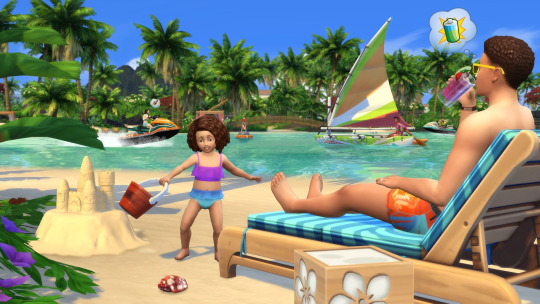
“We want a beach”, we said. So they gave us a beach, and a beach only. I’ve never seen so many people call a pack “shallow” as I’ve seen it happen to Island Living and tbh I do agree with them ‘cause... there’s really not much to do in this pack. For the first time ever swimming was restricted to this pack which is already a big let down by itself, but then features like deep diving were added for no reason and of course, as a rabbit whole, not actually contributing with much to do. So how could it be better?
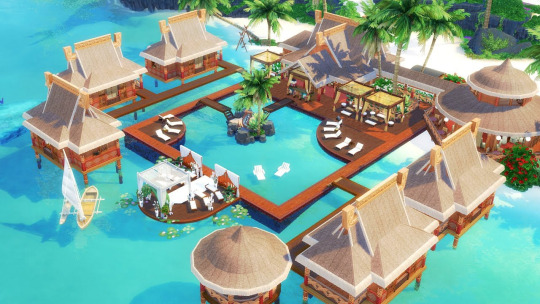
My answer is pretty obvious: resorts. It is a livable world, but that don’t mean your sims can’t take a vacation from work and just stay there if that’s the gameplay you want to go with and resorts match perfectly with that, not to mention it would have great integration with packs like spa day. It also means a new lot type and lot system, that wouldn’t be much new if the city living building condos and sublocating them as I mentioned would’ve already been implemented, but now with the feature of renting it yourself too. Resorts could also have their own event schedules, integrated with the seasons calendar: cava parties every wednesday, yoga lessons on thursdays, etc. And the best thing would be: if you own one, you can make your own events and traditions. imagine just how fun that would be. A feature like this would also mean it’s already done for other packs coming later on, maybe a colder destination where you can ski and build iglus or even another cultural based pack like jungle adventure.

Other obvious resolution would be better mermaids. Make it harder to become one, being only able to get the kelp from a mermaid themselves. Make it less anticlimactic, having an animation of them turning before they just walk in water with a tail all of the sudden, maybe just some scales in their legs. Give them more unique features and powers like vampires and spellcasters have, such as easily persuading people (sort of like the mind control feature aliens have) and maybe even a secret lot, like a grotto where all the mermaids are. Give them curses with the points system to go with it, some mermaids are actually sirens amirite
🥶 Chapter 3: Seasons change, gameplay stays the same

Activities truly based on the season that are specific to that moment create urgency and different moments. Something I can think of is integrating a pack we already have: spooky stuff. It does feel lackluster ‘cause it’s missing opportunities, but imagine going trick or treating but actually going, loading different houses and gathering it while a meter like the active jobs one guided you. Forming groups with friends to do it or maybe for tpeing trees and bushes if you’re on the rebel teen side and destroying their porch jack’o lanterns. It could even be randomly generated, like the game would send you to 3 different houses to do it (that would bring lots of replayability value ‘cause you could end up in houses with neighbors that love you and will give you candy no problem, but maybe also neighbors with family feuds that won’t answer their door or make it harder for you to accomplish the event objectives), maybe one of those could even be a abandoned one that’s haunted or something like that.

The implementing of a better wants and fears system is very essential for this pack. Yes your sims get overheated and a popup message tells you they need some water or lighter clothes, but it’d be so good if they’d actually want to go to the beach, swim in the ocean, take a vacation from work and go to a resort. Heatwaves that would make your sim act weird, not strangerville level of weird, but maybe not obeying your commands.

Blizzards so strong that work and school would get canceled and you actually don’t have the option to leave your home lot anymore until it passes would not only add a different element to the gameplay, but also add value to the weather controler machine.
🥺 Final chapter: The general “more stuff to do” and “more things happening” factor

The game offers all these beautiful secret worlds and yet when you finally get to them there’s not much to do other than searching for rocks and frogs and doing some fishing. I miss going to a community lot hidden somewhere and finding an eremite, goddamn bigfoot, some crazy npc or even just an actual community lot with something to do and people doing stuff in it. Unique community lots would also be a way to make towns more lively and captivating like they did so well with realm of magic and the casters alley section of the world. Maybe forgotten hollow has this abandoned haunted house where people claim they’ve seen the grim reaper walking around. Maybe sixam has a alien station where they clone human sims. Maybe sulani has this beautiful sunken ship beach where a club of people that dress up as pirated meet. Maybe Del Sol Valley has a movie theater where you can watch premieres. Maybe Oasis Springs mine hides actual gold that you can collect and get rich outta nowhere. That kind of stuff.
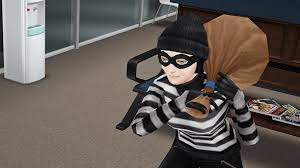
I can’t stress this enough, but NPCs are so important to shake things up. It was so good to have a pack like realm of magic where the we would have to go to the three sages in order to progress. Having unique sims like this or npcs that change the way your story is going like burglars, firefighters, cops, social bunny, bonehilda and even a fortune teller is so important to keep things impredictable and interesting.
Age groups really need more specific restricted gameplay for better feel of progression. Many people say sims 4 is a young adult simulator and well... there’s not much to show that differs from that. Toddlers are as interesting as hamsters, locked in an object waiting for you to feed, clean and give them attention. Teens really should feel more like a transiction period, and the wants and fears system would really help out with that. I miss being able to participate in more elements that would mark a sims life even if they’re cheesy as heck, like having a prom, graduating, having a midlife crises.
In conclusion
First of all: if you got to this point thank you and I’d really wanna know what you think about all of this.
Some people may find even ridiculous for someone to go about a rant this big on a game and to that I have to say I agree lol I can’t help it tho, honestly, the sims has always been the game I’m most passionate about and it helped me express myself and my creativity so much since I was a kid. I really do care about this game and this franchise.
The point I want to make with this is: perhaps we shouldn’t ask for more and more different stuff, but actually put some effort into showing things we already like in the game and how they can be improved to make it more interesting. At the end of the day I still want spiral staircases, ladders, paintable ceiling, werewolves and all that but does it really matter if they get added to the game following the same patterns as the things pointed in here? Also we really are getting to a point where only a few things are missing as far as cas/build/buy go and I believe it’s time for us, as a community, to give gameplay as much importance as all these things we wanted so bad that got implemented. I probaby forgot to say something here and I didn’t even mention the infamous hamster pack, but anyway, I hope the point got across.
I try really hard to believe that the gurus are here for us and that most of all we, as a community, have a very strong voice, all we need to do is make it clearer and stronger about the things we really wish for this game.
#i'm never doing rants again#honestly this is my last one#from now one i'll only express my thoughts through memes and reblogs#ressurrection spell was a missed opportunity for zombies to be back in realm of magic btw#i don't even know how to tag this#the sims#the sims 4#ts4#sims 4
596 notes
·
View notes
Text
Ultima V: Warriors of Destiny (1988)

Summary
Ultima 5 is what you could call Ultima 4′s edgier but “cooler” sibling. The gameplay has gained in complexity, dialogue has been greatly expanded, and the ground-breaking system of virtues and morality from the previous game has been twisted by the tyrannical Lord Blackthorn following the disappearance of Lord British.
Ultima 5 also introduces more of a day/night cycle to the proceedings with the introduction of NPC schedules, enabling a level of world simulation that was very new at the time of release. It goes on to make good use of this system by casting the player in the role of an outlaw fighting against the new government, meeting with members of the resistance in the shadows, and going around the martial law that has been imposed.
Freedom
Just like in Ultima 4, you are dropped into an open world right from the beginning, and your tools to explore the world have been expanded.
The inclusion of more complex systems also enhance the feeling of being able to interact with the world with less barriers, as there is now furniture you can use, barrels you can search, etc.
Like with Ultima 4, there is only one way to win and a list of absolutely required steps that must be taken to reach that victory, but the order in which these steps can be taken is rather flexible, allowing players to create more of a personal narrative as they follow clues they picked up on wherever their instincts or whims took them first.
It is worth noting that there are actually some optional quests dungeons this time around, which is always nice.
Character Creation/Customization
While it is very nice that you can import your character from Ultima 4 into this game, I would say that this aspect of the game has taken a step back in a sense even as it has made progress in other ways.
The eight classes of the previous games have been reduced to four: The standard Fighter/Mage/Rogue Bard trio plus the Avatar class the main character belongs to, which is an all-rounder. As before, there is not really any customization beyond equipment either.
However, the positive of this is that equipment has been greatly expanded from the previous game. While in Ultima 4 you were limited to merely choosing your character’s weapon and armor set from a very short list, Ultima 5 not only enlarges the list but also allows for equipping multiple armor parts (such as a helm or amulet) while also providing a secondary hand slot.
What this means is that two-handed weapons now also give you a trade-off between their big damage and the option to use a shield in your other hand, or even dual-wield.
This greater variety of equipment allows a greater degree of specialization for your party members, though by modern standards this still isn’t much. The supremacy of ranged weapons also continues here, as magic axes are undoubtedly what you should be equipping everyone with later in the game, and now that class does not restrict equipment every single one of your party members will end up in plate with a magic axe.
Story/Setting
This is, in my opinions, one of the most interesting things about the game. Ultima 5 takes all of the virtues from the former game and turns a corrupted form of them into the law.
The game is pretty explicit about this too. Early in the game, in the town closest to the shack you start in, you can find a man in the stocks together with his son. The man is being punished for failing to donate enough of his income to charity as the Law of Sacrifice demands, while his son (who is barely breathing at this point) is being tortured for not reporting his father to the authorities.
Throughout your travels, you meet many kinds of people. From victims, to resistance fighters, to supporters of the regime and everything in between. Throughout your interactions with these groups you will have to discern who can be trusted (generally easier than it should be since the bad guys tend to be meaner or even cartoonishly evil at times) and learn how to fight Lord Blackthorn and the Shadowlords who corrupted him.
The Shadowlords are, incidentally, the part of the story that I don’t quite enjoy. Fantasy is full of one-dimensional ancient evils and dark overlords. By making the events of the game the result of an unambiguously malevolent supernatural force rather than human failings of the type that are not uncommon in real life, the game makes those events feel more distant and less complex.
This very series already has had plenty of “Defeat this one evil force and everything will be fine” plots. They are generally devoid of the moral complexity that the series is now aiming to explore and I want to know what this game would have looked like without the Shadowlords.
Fortunately, however, this effect is not too pronounced. Blackthorn remains a misguided man with good intentions. He admires you a lot, actually, and seeks avatarhood himself. He has such a positive view of the virtues that he sought to enforce them by law.
(Then again, his actual plans for the shrines make this apparent idolization feel dishonest, or at least inconsistent.)
And there is a real type of authoritarianism that functions a lot like this. Even on this site there are many who would be in favor of things like surveillance, police brutality, and harsher punishments. Even on this site there’s a whole lot of people who seek to punish others over stupid things like shipping the wrong fictional characters.
The people I grew up with even went as far as yearning for a dictator who would unleash death squads to execute all the “bad” people. This is a wish that I still see in many people, even those who grew up outside of the circumstances of my country of birth.
This is not an error that humans need supernatural corruption to fall into.
Other than that, I find the dark twist on the existing setting from the previous game to make for a spicier world to explore.
This is also the section where I should point out that Ultima 5 introduces a rather large and dangerous “Underworld” map that is easy to get lost in. While it is mostly barren, you do have to visit various parts of it as part of the main quest, and I just find the concept of a massive dark world beneath the earth to be a super interesting one (I mean, I have even run D&D campaigns based primarily in the Underdark).
I kinda wish there was more to it other than some items and a companion to collect. Something like a town would have been interesting.
Immersion
This is one area where the jump from Ultima 4 to Ultima 5 was massive thanks to the day/night cycles, NPC schedules, expanded dialogue, and even the addition of words of power to the magic system.
But the best thing I can say about it is really that it calls on you to actually roleplay and engage in the world as if you were actually there, at least to a degree, and it does so through a combination of atmosphere and gameplay.
You will not only want to be careful with your words when talking to certain people to avoid being reported to the regime, but you can also learn the resistance password and use it to get help and information from other members.
While these systems are all still pretty rough here, they still come together well enough to make this a lot more immersive than the average JRPG.
One thing that does feel really off is that the guards are not only superhumanly tough but you also lose karma for attacking them. They also behave strangely in that even though you are a wanted outlaw they don’t actually hunt you on sight, only trying to arrest or kill you if you refuse to pay tribute (as if they didn’t recognize you or your companions at all). This despite wanted posters.
So there’s definitely some rough aspects to the crime system in this game.
Gameplay
Massive improvements have been made in this area, and I don’t just mean the above-mentioned expansion of items and the addition of NPC schedules.
For one, enemies now drop things other than gold, such as food and armor pieces. The magic system has also been improved so that you can now mix multiples of a spell at once instead of having to do it manually every single time.
Additionally, spells are now cast using a consistent language of magic composed of several words of power, which you can chain together to produce effects.
But I would say that the single most significant improvement in the gameplay is the simple fact that most NPCs now have significantly more keywords that they react to in dialogue, including many that do not come up through normal conversation with them. The system is still not perfect, but you can have more of a conversation with characters now and switch from topic to topic relatively easily.
In terms of combat, you can attack diagonally now (only monsters could do that in Ultima 4) and random overworld encounters are much easier to avoid now, cutting down on what eventually starts to feel kind of like padding in the previous game (but see below).
Despite the fact that the material rewards from combat have been increased and items are much cheaper now, Ultima 5 is actually significantly more difficult than Ultima 4. Not only do you have less health, enemies also seem to do more damage.
Dragons and daemons in particular are a nightmare, as they can summon more daemons (who can posses party members) and are extremely durable. A single dragon is a very tough challenge for an unprepared mid-level party, and even after giving most characters magic axes they still prove tough to take down while also being extremely damaging. Trying to fight multiple ones at once without blowing powerful spells or glass swords is costly at best and foolish at worst. Dragons are best thought of as boss-level enemies probably.
I am pleased to report that the dungeon crawling is better in many significant ways. Not only are the graphics more pleasant and immersive but also fully cleared rooms no longer respawn endlessly the moment you step out of them (in fact, they may not respawn at all).
It is not all positive however. The descend and ascend spells seem to be nearly useless this time around and the spell to instantly exit a dungeon is gone entirely. This can make getting out of the underworld such a pain at times that you might even prefer to literally kill yourself in-game and lose some XP instead of doing that. Fortunately you can now dig up and bury moon stones, so you can create moongates down there to quickly escape that way.
There is one problem in terms of balance though. While obtaining gear is significantly less of a problem now due to many enemies dropping tons of torches, gems, and keys, your experience will lag far behind your itemization and your quest progress. This means that to actually reach the 8th level and unlock all of the ultimate spells you will need to either explore all the dungeons thoroughly while focusing XP on one character, or otherwise just grind a lot.
Enemies just don’t give enough XP for a smooth progression otherwise. This would have been solved entirely by making significant main quest events (such as finding the artifacts of Lord British or destroying the Shadowlords) grant experience, but no such luck.
This makes for a strange endgame where you’ll have so much money that you run out of worthwhile things to spend it on while at the same time still feeling forced to grind out enemies, even if you imported your Ultima 4 character for an XP boost.
You do want to have access to these 8th-level spells too, as the final dungeon can be brutal without them or items that replicate their effects.
Adding to the experience issue is the fact that you can’t level up at will in this game. You have to camp and hope that an apparition of Lord British will appear and level you up (if you have enough experience). He does not always show up, and as far as I can tell he does not appear at all if you sleep on a bed or camp inside a dungeon. It has to be out in the wild in the overworld (and possibly also in the underworld).
I wish leveling up was just not tied to him at all.
Aesthetics
As is often the case for this series, the game looks and sounds really good for its age. The jump from Ultima 4 is particularly notable, as the level of detail is on a whole other level, particularly within the dungeons.
As with the previous game, the aesthetic core of the Ultima series (after the first trilogy) lies in the virtues. While there is still a karma system involved, it is much simpler than having to maximize eight different virtues. The karma system determines how much XP you lose on death and how much shops charge you, encouraging players to behave (or at least atone for their misbehavior).
But the biggest impact on the feel of the game is the above-mentioned corruption and tyranny affecting the land. Some of my favorite moments were early on, when I was just starting to get involved with the resistance and investigating what was happening around the overworld.
That said, I think that if the guards did actually recognize you on sight and hounded you more aggressively after spotting you the atmosphere could be even better (assuming they were balanced a bit better).
I think some of the music some versions of the game have is quite good too.
Accessibility
This game manages to up the complexity from Ultima 4 while not being any harder to play. Chances are that if you’re importing your Ultima 4 character you will need only a little bit of adaptation to do fine in Ultima 5.
As before, you will need to take many notes throughout the game. More so than in Ultima 4 due to the greater size and density of content. However, if you played Ultima 4 and took notes for it, this is somewhat alleviated. The mantras for the shrines remain the same, and the world’s geography should be mostly familiar (though there have been changes there as well).
You will also still need to consult the manuals and map frequently, at least early on.
The difficulty has also increased dramatically. You will likely end the game with about 200-ish HP rather than 800 and every enemy is much more deadly. Both the early game and the final dungeon will challenge the improvident.
For these reasons, the game is not that easy for newcomers to pick up but I would not call it obscure or complex.
Conclusion
I would say that the positives definitely outweigh the negatives on this one. The story and setting are interesting even if I don’t agree with all of the decisions made in crafting it, and the rest of the game is usually tolerable at worst. Nothing nearly as annoying as Ultima 4′s Reaper and Balron sleep spam (in fact, a plot-relevant item you can find renders Reapers pretty much helpless).
My primary complaint about the game is that the balance is poor. You will end the game loaded with all the items you could ever want while struggling to reach level 8 with even a single character even after doing nearly everything you need to do before the final dungeon.
I know there is a remake of this game made using Dungeon Siege, which I have not played. I think this is a good thing and I’d hope that it fixes some of these issues, but even apart from that I wish there were games that set out to achieve the core concept of this game.
What I am talking about is an open world RPG in which you play an outlaw who must hide from the state and meet other rebels in the darkness, but with complex and mechanically-competent systems to enable all the interesting possibilities this should enable.
I do not assign numerical ratings to games with these reviews, but I can definitely say that I liked Ultima 5 better than Ultima 4. I think it is worth trying even today despite the late game grind.
2 notes
·
View notes
Text
Librarian Idyll - Pre-Alpha 3.7

At long, long last, Pre-Alpha 3 of Librarian Idyll is finally complete.
3.7 has honestly been pretty smooth sailing - overall implementing the resource gathering was a piece of cake compared to a bunch of the other things I’ve done this version, from implementing plants and all their logic for spreading over time to overhauling the targeting system for spells.
I think I spent as much time on the actual resource gathering portion of the update as I did the general version cleanup update at the very end, with all the bits and bobs of features and bugfixes I’ve been kicking down the road to this point.
This update, I’m most proud of how in-world items look and feel and move (I posted a video a few days ago demoing it), and it makes me really excited moving into Pre-Alpha 4, which is going to be all about similar things - making the game look and feel better.
Pre-Alpha 4 is going to be much lighter on the gameplay features front, instead just working on prettying up the game, notably systems for the graphics and UX of the game, including the custom lighting system since Unity doesn’t have a great 2.5d/isometric lighting system built-in yet. That said - I’ll likely do a feature breakdown post of Pre-Alpha 4 later.
But all that said - finally done with 3, and I’m ready to take at least a few days breather before diving back into things.
Also RIP purple bibliomancer main character friend, this is the last update you’ll be in the game.
Full patch notes under the break.
This update, the final one of Pre-Alpha 3, is all about the main goal of Pre-Alpha 3 - actually getting items from all the world resources we’ve been implementing throughout this version. Now you can go out into the (still very small) world, shoot some magic at rocks and trees, and build the library from there.
Core Features
- Spells can now do damage to things that they target, notably mineral nodes and plants. When a node takes enough damage (depending on type) it is harvested. - When a mineral node or plant is harvested, it can drop items that the player can then pick up. Mineral nodes drop stone, ore, and gemstones, while trees drop wood and branches and herb clusters drop, well, herbs. - When gathering, you can happen upon books, because come on - it’s a game about building a library. Of course you’re going to find a book in a tree or tucked away in the cave where you get iron. - Some things, like clusters of herbs, require a bit more of a personal touch than magically uprooting them. To gather these, you just need to click on them to begin sorting through what you’ve found. - Rarer resources and books you can uncover are affected by fortune, making it more likely for you to find things like gemstones with higher fortune levels.
Content
- 2 new spells: Harvest - Uses a fair bit of exertion to gather from trees and mineral nodes; and Cut - Much smaller exertion cost to clear away softer plants like grasses and bushes.
Changes
- Items on the ground have had a number of improvements - One, they will bob gently on the ground, making them stand out a bit more. Two, when spawned they’ll fall to the ground instead of just appearing. Three, they will (for the most part) avoid landing in the middle of things like buildings and other places you cannot reach them. - Added a progress bar above the player’s head while doing things like harvesting resources and casting spells. - Plants can affect player movement speed while passing through them. - Targeting range should behave more consistently when approaching an object from any direction. - It should be easier now to target very small objects. - Large plants and parts of the terrain will make themselves partially transparent when the player is behind them. - Book tooltips now contain what subject they are a book of. Also, children’s and forbidden books now mark themselves as such on tooltips. - You can no longer clear a mineral node by just clicking on it - you will need to use the harvest spell. - Removed the debug herb and resource shops, now that you can obtain most of the items they were selling by gathering resources. - Tweaked some book’s and Cob index’s localization. - Added the game’s version number to the main menu. - Reduced the cost to build the initial library to just 10 slate, 10 supple branches, and 10 simple fittings, so it should be easier to begin building the library on the first day for the time being.
Bug Fixes
- Fixed the small visual indicator on the player that they are casting a spell not layering properly with the player. - Items on the ground will no longer make the pickup sound if the player walks over them with a full inventory. - Fixed an issue where the main menu music would play once and then stop. - Fixed an issue where the exertion bar would still appear when the hotbar was hidden. - Fixed a bug where opening and closing the dev console with a menu open would unpause the game with the menu open. - Fixed a bug where plant data wasn’t being removed from tiles until changing zones. - Fixed ground items playing sounds as if they just hit the ground when reloading them into a scene. - Fixed a bug where if you started a new game after exiting to the main menu from another game, you would start the new game on the date of the old one. - Fixed ferns not having any seasons they could live in. - Fixed a bug where if a plant would spread two or more new plants, only the last plant would properly remove plants it overwrote. - Fixed plants spawning on top of invalid terrain while spreading with the player not in the same zone. - Fixed tile data not being properly loaded from file.
Modding
- A whole bunch of new parameters for plant stages - how many hit points the stage has, what the stage drops, the chance of finding a book on harvesting it, and the sound it makes when it is harvested. - New spell parameters - damage the spell does to targets and locking the target of the spell once casting has begun. - New modifiers - Harvest_Speed, Harvest_Speed_[mineral / plant type], Forage_Speed, Fortune_Rare_Resource, Rare_Item_Chance_[item tag], Items_Dropped_[mineral / plant type / item tag], Book_Chance, Book_Chance_[mineral / plant type] - New actions - StartForage, Buff, Untire
1 note
·
View note
Text
Limited Engagement Commentary (Finally)
Trying to subtly slip this in before the commentary for this week’s challenge. Thanks again for your patience.
This Last week’s contest was a little bit different. Because the design space is narrow – and because the abilities tend to need lots of words – there was only a little bit of room to maneuver in, and yet (fortunately) there weren’t too many significant overlaps in the final designs. That said, it also means that many of the obstacles your submissions faced were similar, so rather than sound like I’m harping on about the same things, I’m going to take a less structured approach to my commentary this week. To that end, I’m also not going to spend time nitpicking templates for the draft effects, little used as they are. Anyhow, without further ado, we can dive in.

@aethernalstars - Whispergear Shifter
The callback to Whispergear Sneak here is cute, even if it did have me confusing which was which all week. The play pattern for this is to remove a relatively common card, and then you’re able to exchange it for one of three cards you chose not to include in your deck. There’s always a pretty high barrier to being worth not simply including a card you want (let alone three), and having to find both this and the card to activate it is probably difficult enough to make it not worthwhile in a lot of cases. The ideal use case would be to have lots of a single common that you would be playing anyway, and three situational cards that you wouldn’t want to mainboard, but even in that case I’m not totally convinced the value of ‘upgrading’ your playables into situational cards really makes the card worthwhile. It’s an interesting idea to add flexibility by accessing parts of your card pool you aren’t planning to play, this card just feels like it may introduce a few too many hoops to jump through to achieve that.

Anonymous - Soul Bargain
This is a really clever approach to a draft-matters removal. Black classically gets two-mana instant speed removal with relevant exceptions, and allowing your opponents to choose the exceptions based on their draft pools is such an interesting direction. There’s value both in revealing bombs (protecting your best cards, albeit with a high information cost) and in revealing commons (which also increases the value of those cards as they appear later in the draft). The biggest obstacle this one faces is tracking: seven different card names every time one of these is drafted is a lot of notation. Regicide required noting three different colors as it was drafted, and I would consider that about the most you would ever want to force players to track. If you could find a way to compress this down to track less information (treat the reveal like a vote, and only note the most voted for CMC or something), I think you’d have a really reasonable design on your hands.
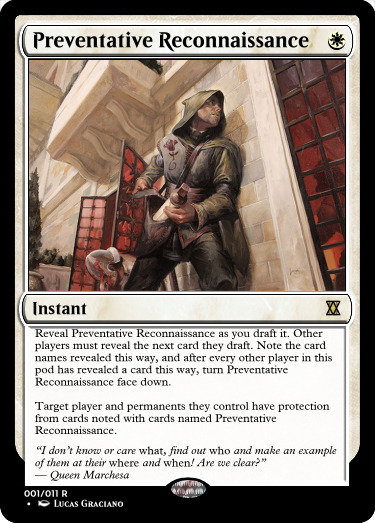
@col-seeker-of-the-memiest - Preventative Reconaissance
This is a new take on white protection effects, protecting a player and their permanents from a specific set of cards your opponents reveal. I’m not sure whether it’s intended to be drafted early (to protect you from your opponents’ first-pick bombs) or late (to cover commons that will actually appear in more matchups), but I think that question is probably interesting enough to warrant the confusion. The bigger issues I see with this design are that it’s really narrow - effects like this don’t often make the cut in Limited to begin with, so it’s especially hard to imagine one that only works against one card per opponent being playable - and the amount of bookkeeping it demands in tracking seven essentially random card names. When you’re playing with this, you’ll likely find yourself (and your opponent) checking and re-checking your list of names every time an opponent plays a new threat. The end result is that this asks for a lot of attention during gameplay, but will rarely actually reward that attention in a meaningful way. The design asks some interesting questions, but I suspect the actual logistics of playing with it outweigh most of those benefits.
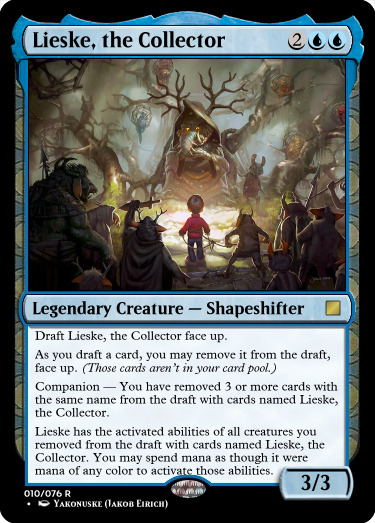
@deg99 - Lieske, the Collector
Interpreting Companion as a Limited-focused mechanic is an interesting take; it always struck me much more as a Constructed mechanic (since you have more control over your deck construction), with the occasions that you make Companion work in Limited being a fun exception. This card takes it in the opposite direction, having its Companion ability only able to be satisfied while drafting; indeed, all four of its abilities only function within the context of draft. The gameplay pattern this demands is that you remove creatures with desirable activated abilities rather than drafting them, and that you remove three creatures with the same name to turn on Companion. I think my biggest issue is that I struggle to see how this is ever better than just playing the creatures you’re removing with it. You’ll rarely ever turn on Companion with this (not least of all because it broadcasts to other players when you’re about to), and whether you do or not, the picks that you invest in it to make it playable should probably just be spent on cards that are playable themselves. I like the idea of a more Limited-oriented application of Companion, but I suspect there are other ways to approach that design space.
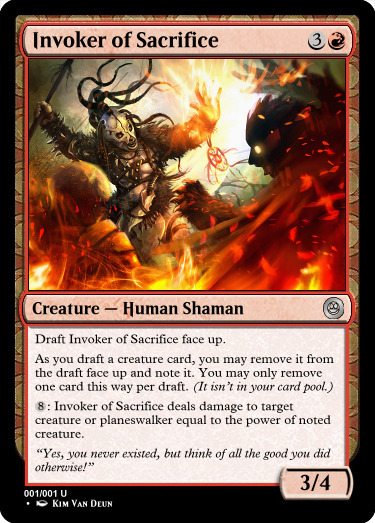
@dimestoretajic - Invoker of Sacrifice
I really liked what this one was trying to do, enough that seeing it in the workshop inspired a design of my own based on it. It’s a little hard for me to tell if the quirks of this one were conscious design decisions, or if they were attempts to make an initial design work without reconsidering the end result. Most cards like this that want to work only once simply turn themselves face down when you use them, and the only part of the chosen card you really need to note is its power; those two changes together would’ve streamlined the templating a lot. Also of note: this card is at its most interesting when it’s having you remove cards that could otherwise be playable for you, but the largest creatures you’re likely to see in draft will often be in green rather than red. That’s not to say the draft environment couldn’t have some high-power red things to tempt you with this, but it’s something to consider when your design starts pulling you in a direction like this one.

@fractured-infinity - Tibalt, the Chaosbringer
This is a pretty interesting card with a lot to evaluate: both how good it is when you bring in the three extra cards, and how good it is without them. Because this circumvents color requirements, it allows you to access cards you couldn’t just include in your deck anyway, but uses randomness as a cost for doing so. All of the mechanics of this card are easy to understand what they’re doing and work together in a cohesive way, which can be tough to do with 13 lines of abilities. The biggest obstacle this one faces is the same obstacle that any card that attempts to balance itself with randomness faces: if getting a free off-color bomb is the fun part it should probably do it more reliably, and if it isn’t then making it unreliable just means we’re allowing one in three games to not be fun. It does change the draft experience by allowing you to grab off-color bombs as you see them, but I’m not sure if that’s an improvement: draft relies on players getting passed the cards that only they can use, and this encouraging you to pick up those cards with no real downside seems disruptive to that process. That the ultimate and the downtick pull in different directions feels like interesting tension, but I think in practice it almost certainly just means that you won’t be using the ultimate. I would probably rearrange the uptick to make the loyalty counters dependent on exiling a card rather than the damage, that way ticking up to the minus (or the ultimate) actually requires you to reset the odds. There’s a lot going on for this card, as is always the case for planeswalkers, and a lot of it feels like good design work. Tibalt was a good choice for this kind of random effect, and I think with a little tweaking there’s probably something of value there.
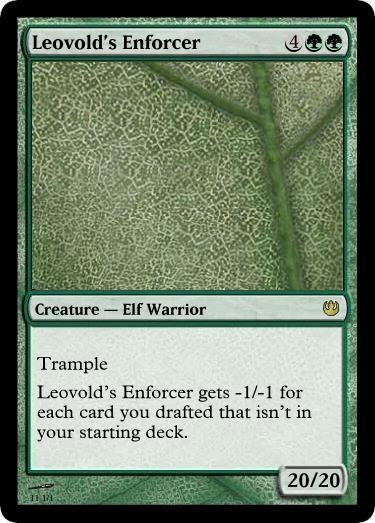
@hiygamer - Leovold’s Enforcer
This design is encouraging you to include as many of your draft cards in your final deck as possible, generally lowering your average card quality to increase the quality of this one card. The ceiling is obviously quite high (a six-mana 20/20 with trample is very strong), but in a normal draft environment you’ll leave out 22 of your 45 draft picks (running the other 23 with 17 lands), making this nonfunctional without special consideration. Like others in this vein, it may work well with cards that remove picks from the draft altogether, though it would require a lot of support to remove enough to make this worth playing. The biggest issue this runs into is actually outside of draft: in Eternal and casual play, this is ‘just’ a six-mana 20/20, and while the theme for this week definitely encouraged you to look at cards through an explicitly Limited lens, it’s still important to consider what those cards do in other scopes. It’s generally more interesting (and safer) to reward players with extras that only work in the format than it is to assume the format and make downsides specific to it. Perhaps there’s space for a conspiracy (which are actually only playable in draft) that leans into similar space as this, as that would sidestep some of those issues.

@hypexion - Court Doppelganger
This is a cute take on a clone effect that is unique to Limited. I’m not sure why this one is a 3/3, as clones are typically 0/0 and this one doesn’t even have the downside of not having something to copy: as long as you noted a card while drafting, it just has access to that for 2UU, so also adding a floor of being a vanilla 3/3 seems unnecessary. I’m not a huge fan of the way cards like this encourage you to draft other player’s bombs - when another player in the draft pod watches you reveal an off-color mythic that would’ve been perfect for their deck that is now suddenly mono-blue for you, they’re going to know it was this card that undermined their draft - I think some restrictions as to what you can clone would go a long way. But the biggest issue that this one faces is actually logistical: this allows you to clone a card that exists somewhere within your deck without a point of reference, meaning that every time you play this card, you will need to call a judge to verify the Oracle text of the card it’s cloning. As a rule of thumb, any card that comes with a built-in judge call probably warrants a redesign to avoid that; something like one of our runners-up this week, which exiles the relevant card before the game for the ease of referencing it later on.

@i-am-the-one-who-wololoes - Riches to Rags
I think what I like most about this one is the way the in-game effect seems to align with the out-of-game effect - both effects encourage you to trash your two least favourite cards, either to or from two different places. Functionally, the out-of-game effect really doesn’t do anything: the last several picks in any pack aren’t much of a choice, so players always wind up with junk they would never play anyway. Each player choosing the two most worthless cards in their pool and shuffling them amongst nearby players doesn’t feel like a really meaningful decision, or that it’s likely to impact the games that follow in any real way. The design feels like there’s something to it, and perhaps with a few more restrictions it could create some more interesting scenarios with a similar framework.
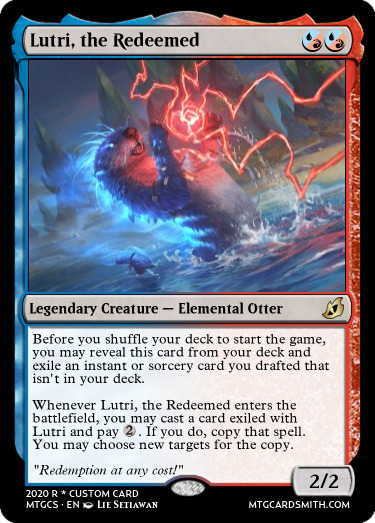
@ignorantturtlegaming - Lutri, the Redeemed
I do love a good redemption arc (I assume that’s what the electricity in its paws is), and Lutri is definitely cute enough to deserve one. I like that this acknowledges some of the similarities of revealing cards before the game with the Companion mechanic, and it’s mindful to play in space that is familiar to Lutri as a character. This design actually comes so close to being especially interesting with a Commander Legends-style draft format, but because it actually casts the exiled card you wouldn’t get any extra value from additional castings of Lutri after the first. If it had used a format more similar to Arcane Savant, it would’ve been interesting in that sense...but that also highlights its biggest issue, simply that it feels very close to a card that already exists. That said, I understand most of the decisions that resulted in them being so similar, and I think with just a few changes you could carve out some space for this that Savant wouldn’t be able to touch.
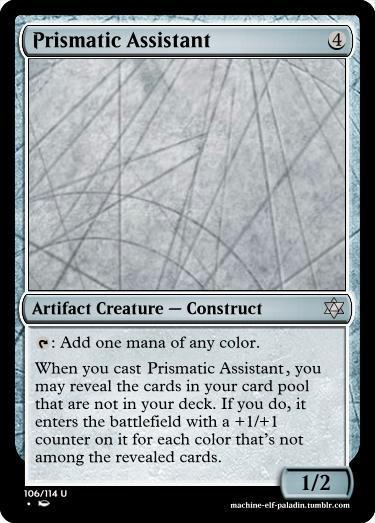
@machine-elf-paladin - Prismatic Assistant
This takes what a lot of the other designs this week were doing, and pushes it in the opposite direction: looking at what you don’t have in your card pool. The obvious question is how big does this need to get to be worthwhile: if you play your entire pool, this would be a 4 mana 6/7, though that obviously impacts the average quality of your other draws. A four-mana 4/5 is pretty good by most colors’ standards, and that limits you to having two colors among your unplayables - so basically all of your pulls need to be in your colors. There’s a question of how many pool-removing cards you would need in a format to support something like this. I think the biggest issue is the logistics of revealing large numbers of possibly relevant cards from your sideboard - it’s correct for your opponent to want to record every card you reveal, even though the majority won’t ever be relevant. Lots of the designs this week struggled with managing the amount of information that they required to be tracked and shared, so I can’t be too hard on you, but it’s certainly something to keep in mind as you design cards like these.
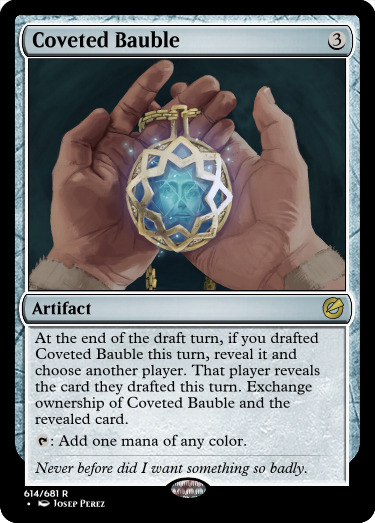
@misterstingyjack – Coveted Bauble
As you probably noticed, your entry was actually surprisingly close to one of our winners this week, which you should take as a good sign! The idea behind your card was quite clever, and had it not been for its similarity to a winning design, surely would’ve been at least a runner-up. What gave the winner the edge over your Bauble was mostly the innovation of making the ability a keyword, but also a few logistical considerations that the winning version executed more cleanly. For instance, the only drafts that could reasonably be interpreted to have ‘turns’ are Competitive events with called (timed) drafts, with most casual events (like this would appear in) using zone, or even looser draft structures. Finding a way to make this ability work in those looser structures is admittedly tricky, but it was probably worth figuring out how to do.
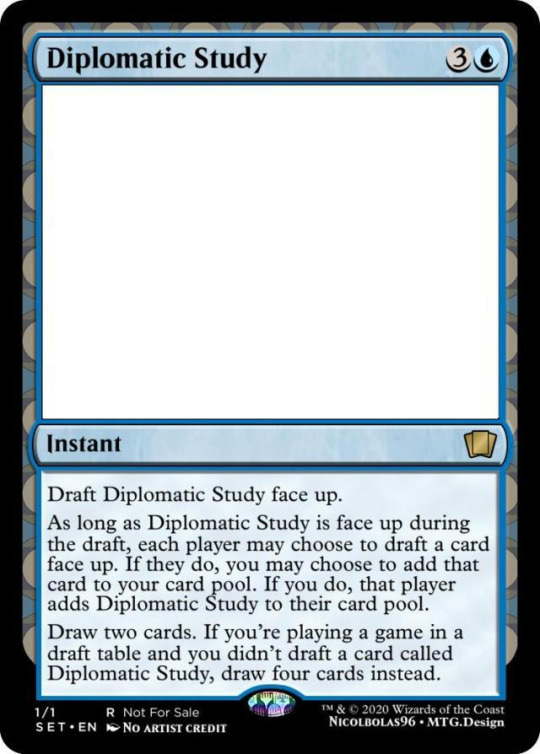
@nicolbolas96 - Diplomatic Study
This one is also a lot like one of our winners this week, though this one plays up the advantages of trading more than either of the others. I quite like the flavour choices on this one, and I really like the design space of things that work best after having moved around the table a bit. The biggest frustration I have with this one is that because the upside is so big, it’s hard to imagine anyone feeling tempted to draft this in the first place - somebody has to, but nobody really wants to be the one stuck with it initially. I suppose it’s better the earlier in the draft you open it, but the card itself isn’t really the kind of game-winning bomb that would be likely to get traded for...well, a game-winning bomb. I think I’d like it if it offered a little more to incentivise taking it initially, so that trading it off is slightly more mutually beneficial when it inevitably happens. It’s worth noting that the “draft table” clause is kinda clunky, but I appreciate your trying to keep it reasonable for casual Constructed as well.

@partlycloudy-partlyfuckoff - Goblin Librarian
I saw your comment mentioning that you missed a line of text on the final version - I appreciate your pointing it out, as the design makes a lot more sense with that included. Missed lines don’t tend to win you prizes, but they do allow for better feedback. This is (supposed to be) a really cute design exploring how big of an advantage you have to offer for players to use their entire card pool. The flavour on this is top-notch, and the effect is interesting enough to make you wonder whether it’s worth trying. One clever quirk of the design is that it (almost) allows you to casually experiment with the Kablooey Decimal system, then switch back to your normal 40 if that isn’t working out. I would probably open it up to “card pool” rather than “cards you drafted”, both so that it theoretically works in Sealed (which this design can do more smoothly than most) and so that it includes basics you add to your pool after the draft (that’s the ‘almost’: since it doesn’t let you add basics, as written you do have to decide to include those in advance, but with a little tweaking that would be fixable). If I had any qualms, I do wish this had a slightly more meaningful in-game effect; I know it’s mostly there for the gimmick, but I think there’s flavourful mechanics that could make this card interesting even after the game begins as well.
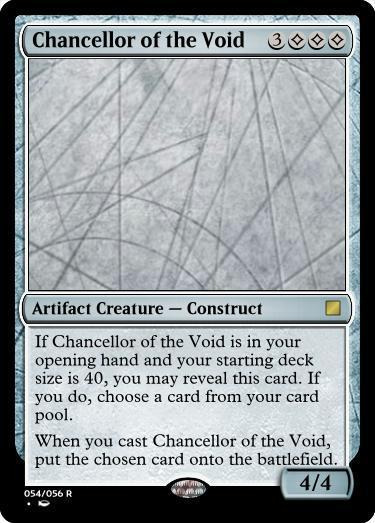
@shakeszx - Chancellor of the Void
This wasn’t the challenge I expected to see a sixth Chancellor in, but I’m always a sucker for a good callback. That said, it’s important to recognise when making such a callback is valuable and when it isn’t. The Chancellor cycle has an identity as 4MMM creatures that have a small additional effect if you happen to have them in your opening hand. Now, this design does have an effect when it’s in your opening hand, but that effect doesn’t actually do anything when it’s revealed. What’s more, the whole card doesn’t do much of anything if it’s not in your opening hand: it’s a very hard to cast vanilla 4/4. On top of that there’s the concern that there’s never been a draft format where triple-colorless was a reasonably payable cost, as well as the logistical nuisance of your opponent counting your deck every time you reveal this card (to ensure you’re not accidentally on 41+ cards). Overall I get the feeling that this design was torn between doing something interesting in Limited and calling back to an old cycle, and both of those goals just got in the way of really delivering on the other.
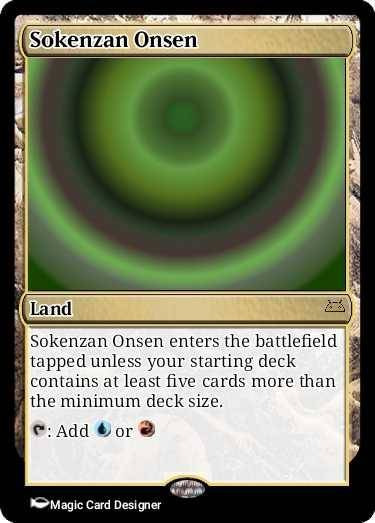
@snugz – Sokenzan Onsen
I appreciate the attempt at subtlety, though I did try to let on that subtlety wasn’t expected with this week’s contest: I gave you free rein to explicitly reference elements of Limited. Unfortunately, it’s hard for me to agree that minimum deck size manipulation is primarily a Limited thing after watching Yorion terrorise Standard over the past six months. Challenge aside, something like Yorion’s success proves that for certain decks (namely Control variants) there is relatively little cost to adding extra cards, and in this case five cards is an especially small hoop to jump through. Logistically, it seems a little unpleasant to verify – when you play this on turn 3, your opponent suddenly needs to count your library, your hand, your graveyard, your battlefield, and anything you have in exile to make sure you actually had five over when you started. It’s honestly a pretty neat idea and I’d like to think there’s some design space for deckbuilding restriction duals, but I think there’s a little cleaning up to do on this one before it’s practical.

@starch255 – Shambling Scrapheap
I see what you were trying to do with this one: the balance between how many of these commons you keep in your deck (to increase how often you see it) and how many you leave out can create an interesting tension. I see why you say it’s most interesting in draft, as it’s certainly much less interesting as a 3-mana 4/4 that eats your sideboard slots. But even more than that I’d be worried about this in casual, where a card like this is actually liable to see play: where players are encouraged to collect them by the dozen, but where the result isn’t particularly fun when they do so. There’s definitely room in Magic for Relentless Rats-style cards that encourage players to collect lots of them, it’s just important to be mindful of what actually happens when a player finally ‘does the thing’, and whether what you’re subtly encouraging them to do makes the games where they do it more fun, or less.

@teaxch – Custodi Apocrypha
This is an interesting build-around rare that if drafted early allows you to really shape the rest of your draft around it, and automatically tells you something about the draft environment it must fit in. I think rare is probably the correct place for this to sit, both because it has a pretty huge color pie effect and because multiples in a single draft pod would create lots of competition for Auras. This is a solid design that I can imagine as part of an interesting draft format, and the only thing holding it back was that – as you noted – it’s just not doing anything especially breathtaking.
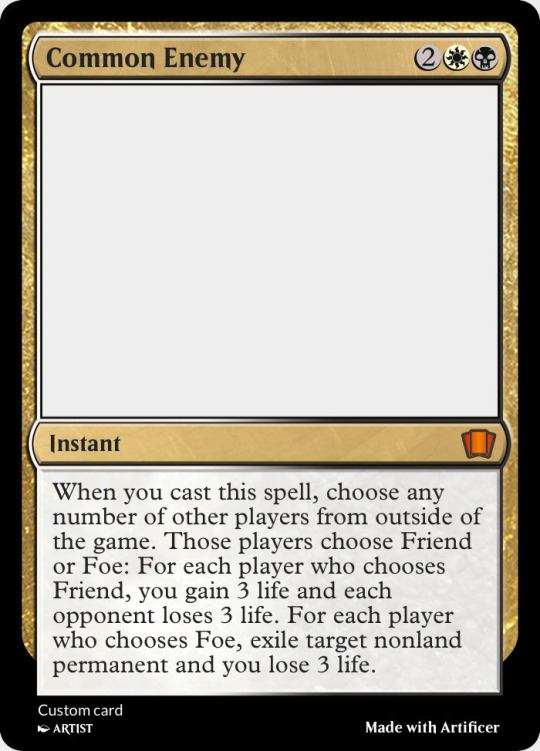
@thedirtside - Common Enemy
Thinking to use the other players in a draft pod (or sealed event) as a resource is a really clever take on this week’s challenge. Unfortunately, I don’t think there’s a way that the rules can actually support “players from outside the game” - I’m afraid it’s something that will be relegated to silver border for some time. I think the closest you could come to this would be to do the vote as part of the draft process: that reliably gives you seven other players, and the game can reasonably obligate them to make a choice (whereas this design currently doesn’t do much if there’s no one to ask or they decline to choose). In practice, this card seems awfully swingy - often you’re going to have players outside the game simply picking a winner, as anything more than one outsider results in very large life total changes. There’s a slight templating hiccup here as well: this spell as written only has one target, so you’d have to do a little reconfiguring for a spell like this to determine the correct number of targets as you’re casting it.
7 notes
·
View notes
Text
Third and final post: what were my other thoughts?
Let’s talk about the game’s mechanics first.
I am overall very pleased with the battle gameplay. On the battlefield itself the gameplay is more-or-less unchanged from the past, but the character advancement and customisation system is significantly improved. Moving to a single overall character level and giving every character the ability to change classes at will is a much more fluid and elegant system than in the past, and the ability to choose the specific combat arts and abilities each character takes looks like it adds a lot of depth. It’s probably appropriate for the overall ‘teacher’ theme of the game that you have much more power to mould each character’s skills and talents, but I’d like to see it in other games as well. There’s an important balance to strike: on the one hand, characters should not be infinitely malleable, and should all have their personal strengths and weaknesses. On the other, so much of the fun of the game is in developing characters and watching them grow that it’s really good to be able to specialise them.
Speaking of battle gameplay, divine pulse is great. The Fire Emblem series has always struggled a bit with accessibility, and while casual mode definitely made the series easier, it also felt to me like missing the point. Casual mode is too easy, and by removing any risk of permanent death, it felt like it removed a lot of the game’s tension. Divine pulse is a much better way to make the gameplay a bit easier and less frustrating while still keeping the same feel as classic FE gameplay. It gives you just enough room to survive a lucky enemy crit, or a small misjudgement on your part, without totally removing the need to be careful. I approve. That said, I did feel that by late-game you probably had access to too many pulses and it removed the need to conserve them. With a dozen pulses, there isn’t much risk any more, whereas if it stayed capped around three to five, each individual pulse might have felt more precious.
(Apparently Mila’s Turnwheel in Shadows of Valentia actually did the mechanic first, and I totally forgot about it. Oh dear…)
Other gameplay innovations were more hit-and-miss, for me. Battalions were fine, but I don’t think I would have missed them if they weren’t there. They helped make the battlefield seem busier and more populated, but they don’t seem to have had a massive impact on the game. Similarly, monsters were mostly fine (Cindered Shadows boss notwithstanding), but again, I don’t think I’d mind very much if they didn’t come back. They rarely actually felt like the most dangerous enemies on the battlefield, and just required a slightly different strategy, and… well, maybe it’s just me, but it feels weird for FE to have boss monsters like that. I suppose arguably it’s been a tension in the series going all the way back to the original game? Marth was supposed to fight monstrous dragons, but his entire game was about enemy soldiers, and dragons didn’t stand out as the terrifying beasts they ought to have been. Still, I’m not sure I’m sold on them here.
When I started playing I complained that exploring the monastery was tedious. You can get into a routine later on, but for the most part, I did think it could have been streamlined more. Having lunch with students or going for special training or browsing the marketplace are all fun things to do, but a bit less sprinting all over the map to talk to everyone and return lost items would have been appreciated. The lost item mechanic in particular feels like busywork. A bit of exploring is nice, but only as long as it doesn’t get tedious. It might have been lovely to explore other locations as well – Enbarr, Fhirdiad, the army camp outside Gronder, etc. – but I can understand that the amount of work required would not be practical.
Speaking of tedium, though… I really could have done with a few more maps. Maybe this is my fault for constantly choosing battles, but I found myself replaying the same forest, plains, beach, or volcano map too many times for comfort.
I might also have liked for crests to be a bit more mechanically impactful, given their important to the world and the plot. I regularly forgot which of my units have crests, and what any of the crests do, since most of them have so little effect as to not matter. The only one I did usually remember was Felix’s Crest of Fraldarius, and that was mainly because it makes him do more damage and sometimes made him kill people I’d hoped to leave on one or two HP. I don’t think crests should have been overpowering, but a little more power would still have been nice. It should not have been so easy to forget that they exist.
Similarly, by the time I finished the game I realised that I had never used a Hero’s Relic, even once. I would like to say that this was a principled decision on my part, given that they turn people into monsters (and it looks like I was right about them being made from bone?), but it was mostly just the BUT-WHAT-IF-I-NEED-IT-LATER effect. They all have quite low durability, and while I understand that infinite durability, as with relics in previous games, was not an option due to breaking how combat arts work, it was still enough to discourage me from using them. Perhaps on a higher difficulty they would become necessary? I always feel a bit sad when for mechanical reasons I never let characters use their most iconic weapons.
Moving on from mechanics…
There is technically a shipping mechanic, with an S support for the protagonist, but it really felt like an afterthought to me. I don’t think the game would lose anything significant if you just removed all the S supports. Compared to a game like Awakening or Fates, where the second generation makes it mechanically important and the plot seems like it works best with a bit of romantic drama (f!Robin/Chrom and m!Robin/Lucina looking particularly intended), Three Houses is surprisingly chaste. I suppose picking a character to be your waifu might be part of the culture now, perhaps looking also at the growing influence of waifu gacha games, but for me it felt tacked on. I can imagine potentially rewriting the game to make romance a more important theme – perhaps talking about Jeralt and Sitri a bit more? – but to be honest I think that that would have been worse for the game overall.
In particular, it stands out to me as sitting a touch oddly alongside the teacher concept. One of the things that stands out to me about Byleth as a protagonist is the way that Byleth is in a superior position relative to the other units. You are a professor, in a position of authority, and you have more life experience. Your job is to teach and mentor these younger characters. This contrasts strongly with Robin, who I think was presented as the equal of the other Shepherds (your relationship with Chrom is that of comrade and friend), and with Corrin, who was presented as an inferior or junior (your siblings are older than you, and they start off with higher status). Because of that superior position, then, I found the game suggesting a feeling of responsibility towards them, and a feeling of pride in their accomplishments.
This might be a bizarre comparison, but in some ways a game that Three Houses reminded me of while playing was Princess Maker 2, a weird little DOS game from 1993 about raising a girl. The core loop of choosing activities to raise the stats of a character in your care, punctuated with occasional outings to fight monsters and get loot, felt quite similar. Similarly, the emotions that seemed to be evoked, to me, were emotions of care and pride: perhaps not paternal as such, since Byleth isn’t that old, but certainly the satisfaction that comes from nurturing a younger and less experienced person.
For the most part that actually worked, and I certainly applaud it for feeling less icky than Fates. If I compare tea parties to that weird Fates mechanic where you could invite characters to your room and touch their face, it is vastly less creepy. So I’m glad that the romance has been toned down.
And speaking of things that I’m glad aren’t prominent…
I’m deliberately burying this part in the middle of a long post. Tumblr is famously ruthless on issues like this, but fortunately I have a very low follower count and you’re all nice people. Basically, one of my worries going into the game was that Three Houses might be the ‘woke’ Fire Emblem game. I am glad to find that concern averted, at least so far. A person could perhaps make some pretty cringeworthy interpretations of Duscur to do with racial politics, but the game itself does not push you in that direction. Tumblr and AO3 love slash shipping, but as far as I can tell that remains as canonically unsupported as ever. Interestingly, while Three Houses has a small handful of same-sex romantic S supports and endings, as far as I can tell they’re all for Byleth and they’re all simply copy-pastes of the opposite-sex versions. It’s enough for me to genuinely wonder whether they’re in the original Japanese at all, or if they were added. I know translations of FE games have played around with character sexualities before, so it’s possible. At any rate, part of me was concerned that this might be the Dragon Age: Inquisition of Fire Emblem, and fortunately it isn’t. (I mean, I did actually enjoy Dragon Age: Inquisition, but at times it did get to be a bit much.) I’ll take this as a valuable lesson when it comes to not believing posts I see on Tumblr. You’d think I would have learned from previous games: popular fan interpretations of a character are often completely wrong. Three Houses seems for the most part to be a very traditional Fire Emblem game.
In terms of the overall series trajectory, I take Three Houses to be an overall positive sign. Awakening and Fates seemed to be taking the series in a direction that I didn’t care for as much, with heavy use of player avatar characters, much more fan service, and more trope-driven plots. Three Houses seems like a return to deeper worldbuilding and characterisation. The cast of characters overall has definitely been a high point: in Fates I sometimes struggled to build a team of characters that I felt truly fond of, but in Three Houses there were usually more characters I wanted to use than I had space for, and there were no recruitable characters that I truly disliked.
Really, the biggest disconnect between me and Three Houses, in the end, is the fact that Three Houses is built for replayability, and I don’t like replaying games very much. However, I don’t think I can in good faith call that a flaw or poor design: obviously there are a lot of people who love replayability, and considering that I got a good eighty hours of gameplay out of my first playthrough (DLC included) and enjoyed it, I’m not really in a position to complain.
So in the end, then, I think that while Three Houses is not my favourite Fire Emblem and does have some places where it could be improved, for the most part I think it’s quite a good outing and a significant improvement on the last few. It is not designed entirely to my tastes, but what is here is mostly good. Three Houses leaves me feeling much more optimistic for the future of the franchise than Fates did.
9 notes
·
View notes
Text
Hitman 3 Review The latest Hitman trilogy came to an end. IO Interactive learned from the mistakes…

The latest Hitman trilogy came to an end. IO Interactive learned from the mistakes and successes of the past and applied its learning in Hitman 3 . Agent 47 is ready to embark on a new adventure that promises endless playable possibilities.
Gets it? I tell you about it in this analysis. Five years have passed since Agent 47 reappeared with the aim of showing that, despite being a long-lived franchise in the action title genre, it was still capable of delivering fresh experiences from IO Interactive .
Although the first installment generated controversy due to its episodic format, the new trilogy knew how to get up and move forward firmly to consolidate itself. Now we are living the culmination of a proposal that has improved title after title.
Hitman 3 , in addition to being an exceptional closure that no fan of the character can miss, is a clear example of the potential of the Danish study.
Innovating in a saga like Hitman is not an easy task. Especially because its playable bases, those that have accompanied the franchise since its inception, are mechanics that cannot be separated from without altering the identity. An identity that, by the way, has been forged over two decades.
So the goal of IO Interactive was not to reinvent the wheel, but to expand the playability possibilities and enrich those experiences that we have already had with Agent 47 for years. It is important to note, however, that on this occasion those in charge decided to devote more attention to the narrative section.
Hitman 3 stands out for an extraordinary level design and an outstanding audiovisual section
Hitman has never been an exponent, much less in the way of telling stories. With Hitman 3 is no exception. Although there is clearly an effort to make the narrative become an important element, unfortunately it falls halfway.
It’s not that the story is boring; in fact it has certain twists and turns and interesting moments that make us know more about the situation that Agent 47 drags from the previous games. The main problem is that the story never manages to catch up with the rest of the playable proposal. Consequently, it goes unnoticed much of the time.
So expendable is the story of Agent 47 that his stumble does not affect the rest of the game in the least, fortunately … However, there is that negative feeling because it is a margin for improvement that they have never been able – or wanted – to take advantage of.
I do not know if it is a deficiency of IO Interactive in the narrative field or if at some point they decided that it was not worth taking a risk with a more elaborate proposal.
Tom Holland’s ‘Chaos Walking’ may be the worst movie of 2021
I would bet more on the second. And as I mentioned previously, it doesn’t affect the entire product because Hitman , for better or worse, has never tried to excel in his argument.
Beyond the main story, Hitman 3 also offers us a series of short narratives that are available in each level. I mean the ** »Mission Stories» **, a group of objectives that make us live brief adventures within the same setting. Most consist of completing various tasks until, finally, having the victim at the right time and place to kill him.
Each level of the game offers three “Mission Stories”, however, the way to deal with them can vary completely depending on our actions. This is where the myriad of playable variants of Hitman 3 begin to be glimpsed .
Xiaomi’s new Redmi Note 10 Pro Has Everything To Become a Best Seller
Another key point is that the three stories are not available from the beginning. You must complete the level to unlock them. This is just one example of how IO Interactive seeks to get the player to visit the same level over and over again . Is it generating a repetitive experience? Not necessarily.
The reality is that it is up to you to face the mission in one way or another. The limit is your imagination . If all of the above is not enough for you, you should know that each level has dozens of challenges . Yes, dozens. Although some can be completed in the same attempt, you will have to revisit the level several times to complete them all.In addition, everything contributes to obtaining a better grade at the end of the level.
Best of all, the challenges are very different . From carrying out assassinations with different weapons, objects and tools, to interacting with the scene and using it to your advantage to get rid of witnesses and enemies.
Once you take a look at the extensive gallery of challenges offered by level, the next thing to do is plan your execution. Be careful, some will require you to break your head when planning them and when trying to execute them. This is precisely the greatest attraction of Hitman 3 , the freedom that you have to beat its playable offer as best suits you; to experience one and the other possibility, no matter how far-fetched it may seem.
Of course, this freedom goes hand in hand, first, with a set of mechanics that are inherited from the titles that precede it. No, there are no changes to the basic gameplay of Agent 47. However, there was also no need for a twist. IO Interactive focused on enriching the gameplay with the help of an inventory of objects that can be quite varied and, of course, with a level design that borders on excellence .
Beyond the visual section, which I will delve into later, the levels were created with the purpose of making the most of the gameplay. And it always comes out triumphant in that area.
Xiaomi’s new Redmi Note 10 Pro Has Everything To Become a Best Seller
During your journey through the levels, and with the help of instinct mode , you will be able to locate interactive elements that can get you out of a tight spot or make your mission easier. The variety is very wide and its use is again subject to your imagination. And when it comes to items and weapons, the amount available is staggering. The funny thing is that even the smallest item can be a lethal weapon.
For example: a banana – no kidding. It will be up to you to explore the scene for other objects that are also useful and do not attract attention, as drawing your pistol at an inopportune moment will cause an uproar.
Of course, a part of the great effectiveness of the mechanics has to do with the behavior of the enemies, which is sometimes ridiculous. I missed that they had a more challenging artificial intelligence . That they were able to identify that the bald “military man” walking beside them is the same one who moments before was dressed as a janitor.
Going unnoticed is usually very easy even after being identified as an intruder. I suppose these kinds of nonsensical moments are part of Hitman’s identity and are equally responsible for making it more fun.
Tom Holland’s ‘Chaos Walking’ may be the worst movie of 2021
I could not finish the analysis without highlighting an outstanding audiovisual section in each of the six locations we visited: Dubai, England, China, Germany, Argentina and Romania. The graphic level of Hitman 3 is worthy of the start of a new generation. I had the opportunity to enjoy it on a PlayStation 5 and there is nothing to fault for the visual quality.
The attention to detail on the stage is to stand up and clap your hands. Not so in animations, which still have room for improvement. Something that will immediately steal your eye, at least in the next-gen version , is the huge number of NPCs of certain levels. These are moments when you really feel part of a live stage. And of course, playing at 60 frames per second always makes a difference.
Conclusion
Hitman 3 is the culmination that the trilogy deserved . Agent 47 says goodbye, for now, with a delivery that can offer you dozens of hours of fun. As long as you are willing to revisit the levels in order to overcome its many challenges.
Although there are no significant news regarding the previous two titles, IO Interactive has been able to enrich its formula to expand the possibilities of the World of Murders. The Denmark studio exposes their ability to design levels, an ability that I hope they can capture in their adventure with James Bond himself.
Pros
A level design that borders on excellence.
The freedom to complete objectives.
Dozens of hours of fun thanks to the challenges.
Outstanding audiovisual section .
Cons
The story again is a must.
The artificial intelligence is poor.
2 notes
·
View notes
Note
I just got VTM. Aside from the unofficial patch, any advice for a new player?
Well first off, I’d advise saving the Malkavian and Nosferatu clans for later playthroughs as Nossies can be more challenging with the whole ‘being seen violates the Masquerade’ thing, and Malkavians have uniquely written dialogue which comes with some pretty heavy foreshadowing.
Aside from that, all the clans have different strengths and weaknesses:
Toreadors are great for a high humanity, charisma based build, but any decisions or actions that result in a loss of Humanity will be doubled for a Toreador.
Brujah are good for combat builds and with their Presence discipline can help with any social situations they find themselves in. They’re more prone to Frenzy though, so you’ll need to keep an eye on your blood supply to avoid that.
Ventrue can Dominate others and with Fortitude they’re really hardy, but there’s a chance they’ll vomit when feeding on ‘poor quality’ blood - aka beggars and sex workers - as they tend to come from upper class families, such as royals or CEOs etc. They’re the Blue Bloods of the vampire world.
Gangrel are a more combat oriented clan; they’re also more prone to Frenzy than most clans as they are closer to the Beast. Their disadvantage on Frenzy checks isn’t quite as bad as the Brujah’s though. I forget if it’s in the vanilla game, but I recall them having penalties on charisma-based skills too (which is why I play a charisma-based gangrel lol)
Tremere are blood mages and, thanks to Thaumaturgy, are very powerful, but they can’t raise their Physical skills above 4, so it’s not really worth investing into trying to make them melee fighters.
Nosferatu are hideous and being sighted by mortals will cause Masquerade violations and they can’t raise their appearance/seduction skills at all. They are skilled in stealth and hacking, and are handy in combat. While the sewers can be navigated by all clans, the Nosferatu have to learn how to navigate them to get around Masquerade Zones unseen. Combat zones are a free-for-all fortunately.They also get more blood from feeding on rats than the other clans.
Malkavians are clinically insane, and the player in particular seems to be something of an oracle; their dialogue may be hard to interpret at times, but otherwise they’re useful for a charisma/stealth build.
Second, the game’s development got rushed so while a lot of it can be navigated with social skills and/or stealth, there are portions in the later game that are very combat heavy and unavoidable. They can be a real pain, so unless you’re okay with using cheats to make yourself invincible (which is what I do after beating the game fairly once), make sure you do invest in some combat skills at some point.
In terms of mods...
There’s the Clan Quest Mod, which comes with the Unofficial Patch and some other gameplay changing mods which you can try out if you like - it adds a unique quest for each clan, as well as a whole new questline with the Sabbat faction. It’s not a must have for your first playthrough, but something you may want to check out at some point.
If you struggle with, or just don’t like, weird fonts then this is a must have. It’s intended to clean up the Malkavian font, but there’s files that change all special dialogue fonts to be more readable.
There’s also the Hooded Nosferatu mod that makes the player look less like a monster running around in BDSM gear and more like someone who’s at least trying to disguise themselves. It’s a matter of preference ofc.
Aside from that, most mods are reskins and retextures that can be installed by dragging and dropping into the appropriate folders in the Unofficial Patch folder. Some improve the textures, others straight up change how things look. It’s a matter of finding what you like.
I hope this helps out, I’m not overly great at explaining things, so if anyone would like to add anymore advice then go ahead ^^
@mudbloodedslytherin
46 notes
·
View notes
Text
HPWU: A One Year Retrospective
Harry Potter: Wizards Unite turned one year old last month, and over the past year, it has improved a lot.
This review is looking at HPWU as a standalone game, devoid of the context of the book series, any views of its author, the movies and spinoffs, or any other media associated with the Harry Potter franchise. I have plenty of opinions thereof, but they are not directly relevant to my opinions of the game and how it functions.
The game at its core is not particularly inventive, and at the beginning of its first year, it mostly felt like a reskin of Pokemon Go. Spawns appear on the screen based on a map that a player traverses in real space, and players must tap on the spawns and then attempt to collect them in order to complete their collections. But instead of catching Pokemon to fill the Pokedex, players are rescuing “foundables” from “confoundables” to fill their stamp collections. Unlike Pokemon Go, multiple copies of each foundable must be collected in order to acquire the stamp, and once the entire page of stamps is collected, it can be prestiged in order to start the whole process over again.
Traversing the world, though, can prove to be complicated in anywhere but the most urban of areas. I live in an urban area, close to my local downtown, and at the game’s inception, I had to walk pretty far in order to complete my daily F2P chores each day. See, all of the POIs (points of interest) on the map are auto-generated from the data in Niantic’s original game, Ingress, and each POI is randomly assigned to one of three types. Inns, where players can acquire spell energy, are the most common. Next are greenhouses, where players can acquire potionmaking ingredients and occasionally, more spell energy. And the least common of these POIs is fortresses, which allow players to enter timed dungeons either by themselves or with other players to fight baddies and get prizes for their efforts.
The randomness of assigning each of these three types of POI is a real drag for many players. When the game was first released, I had two greenhouses and one fortress reasonably close to my home. This was enough to play the game, as greenhouses also occasionally awarded spell energy just like inns, except that the dailies explicitly required me to interact with two inns each day in order to get any premium currency. And as I mentioned, the assortment of POIs was completely random! Some players found themselves with nothing but fortresses around, while others had only inns and no fortresses for multiple kilometers. I considered myself relatively fortunate that I only had to walk 1 km to get to a nearby inn!
But unlike Pokemon Go, while the game encourages exploring, the core mechanics are not well suited to walking. In Go, a rare spawn can be easily subdued in 1-2 attempts, and curveballs are quick and easy to throw. In HPWU, the rarer the spawn, the more difficult it is to capture, and the more likely it is to run away. Foundables are captured by tracing patterns on the screen, and they all have a rather low acquisition rate, which means the rare ones are more likely to flee than to stay put unless the player pours consumable items into their capture. And even so, a player having to trace the same pattern multiple times just to capture a single spawn means that there is much more time standing in one place and less time walking. This is not an exercise game.
And this is one of the core flaws that has plagued Wizards Unite since its inception. It’s a clone of Pokemon Go, but every single mechanic that differs from Pokemon Go brings it further away from Go’s vision of an exercise game. Wizards Unite is an augmented reality exploration game, but it’s more about exploring a story and a setting than about racking up burned calories. This is especially apparent in limited-time events that encourage players to spend multiple hours standing still by the same POI, challenging hordes of enemies.
Monthly Community Day events aside, the regular cycle of in-game events was fun and engaging at first, but it quickly grew dull as players finished the main story quest and found the primary content of the game to be the fortnightly events. This is always a struggle for F2P games, especially games that rely on collections rather than PVP mechanics. The events weren’t even new content, merely recolored versions of content that already existed in the games, spawning much more frequently than other foundables and with featured spawn rates. What was fun in the game’s first few months had quickly become tedious, especially when the featured foundables had low catch rates.
Despite this stagnation, the game has changed over time, and many improvements have been made. The tonic for trace detection, a craftable potion that allows players to summon foundables to wherever they are, was long overdue when it was introduced into the game, allowing players who were less mobile to encounter more foundables when they had time to play. Inns and greenhouses were rebalanced so that inns in less urban areas dropped more spell energy, and greenhouses’ spell energy became guaranteed, rather than a 50% drop rate, which was an important improvement for areas with a low POI density and an active playerbase. Adventure Sync was added, which allows the game to track steps. (Unfortunately, this feature does not function well, as the steps counted toward daily tasks only begin after the player’s daily login bonus, and AdSync requires the game to have access to the player’s GPS while the game is closed, which drains phone battery in the background. Players who already have AdSync enabled for Pokemon Go will not notice much difference.)
The most significant overhaul, of course, came with the onset of coronavirus. In order to allow players to continue playing from their homes, the daily requirement to interact with inns was removed, and the Knight Bus, which allows players to remotely access fortress challenges and even engage with other players remotely, was implemented. I have found that the implementation of the Knight Bus almost single-handedly revived my interest in the game when I had grown completely bored of it, as it was a lot more fun to play fortress challenges with friends, which I had barely been able to do before, than to play the game solo.
But these improvements also serve to highlight the flaws in this game that have not been improved since its release. Trace completion always takes a particular shape, and its right-handed bias is clear the moment one attempts to complete a trace off-handed. The swirl of Ebublio, in particular, which takes an “e” shape, feels much more natural in the counter-clockwise direction in the right hand than in the left. Mirroring traces in a left-handed or “mirror” mode would be an easy fix!
SOS assignments have not been updated since day one of the game, and they have said “new assignments coming soon” since I completed them. In my first few months of playing, that was the real draw of the game for me, finishing the story quest and continuing on to the next page to see what would happen next. Each event feels like filler, while what would have made the most sense would have been to add four or five new pages of story quests every few months or so. And they (and all other events) aren’t replayable, so when WB/Niantic/whoever is responsible finally gets around to adding them, we’ll all have forgotten what happened. I already don’t remember.
Finally, the entire story as a whole, which is told as a haphazard, shoddy, zigzagging extra flavor to the repetitive, bland events, could have been told with just a week or even a day of gameplay in a regular game. “What is causing this calamity?” the characters ask. “I don’t know, but let’s patch the problem and investigate the cause later. Maybe the identity of the next problem that arises will give us a clue.” The game relies on half a dozen characters who show up just to give the player instructions, and it is somewhat over-reliant on the draw of the property to encourage players to invest themselves in the game. This is not good for a game that is mostly divorced from the primary story of its franchise. Assuming I knew nothing about Harry Potter or his universe before playing this game, and even if I do, there are way too many characters, and no documented point of reference for a player to look at for a reminder. The main characters seem to be Constance Pickering and Hermione Granger, with a splash of Harry Potter and a pinch of Ron Weasley thrown in. Their commentary doesn’t add much to my engagement because it’s the same mildly curious “I wonder what’s causing this” speculation we’ve had since the beginning.
Good stuff appears to be coming soon. The strongest aspect of the game is the ability to customize one’s character with an ability tree, which lends more variety to the way players can interact with the fortress challenges. An upcoming update is set to add this customization to the map screen, which may give this game the new life it so sorely needs.
All in all, judging Wizards Unite by its gameplay and content alone, and divorcing it from the source material, I’d rate it a C+. The game isn’t sure what it wants to be. It advertises itself as an exploration game, but punishes walking and rewards standing still. Adventure Sync once again rewards walking, this time when the game is closed, but the player is again punished, this time by severe battery drain. The game leans heavily on its story, but the story falls short due to poor updates and over-reliance on events to tease rather than deliver new story elements.
And of course, if we are to judge the game based primarily on its being an entry into the Harry Potter franchise, then we must begin to judge it on the merits and flaws of the franchise as a whole, which is a discussion for another day. If we don’t measure it against the franchise, there is much in the game that will be confusing to a player unfamiliar with the series. Who are these people, and why are we rescuing them? Why are we rescuing this one man some of the time, and attacking him other times? Four of the six pages of stamps feature characters from the franchise heavily. Players who aren’t invested in the franchise won’t care too much about them.
To someone who isn’t interested in the Harry Potter franchise, or to someone who was previously interested but has become disillusioned with the author of the series, I recommend you pass on this game. However, longtime fans who can still derive pleasure from the series, who separate the creator from the creation, or who view this and other derivative works as their own entries, created by teams rather than by the one who started it all, may enjoy this game.
1 note
·
View note
Text
Doom WADs’ Roulette (2002): Alien Vendetta
#1: Alien Vendetta
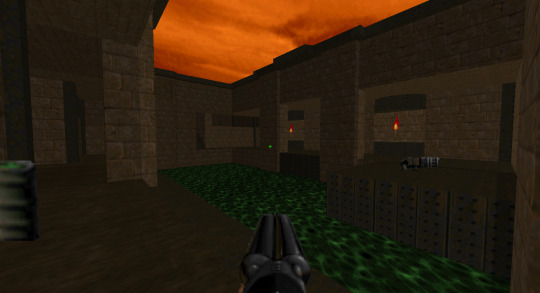
Main author(s): Various (Idea started by Anders Johnsen)
Release date: December 24th, 2001 (original release)/December 24th, 2002
Version(s) played: Second version/Compet-n edition
Required port compatibility: Vanilla (for almost every map)
Levels: 32 (standard 30 + 2)
Welp... I guess we will have to start off from the beginning. And we are starting with an absolute classic according to many people (that I played before because Dean of Doom happened).
Now, look, if you heard about Alien Vendetta being hard and thought This guy must be exaggerating. It can’t be that hard. then let me tell you something: You will be surprised. This WAD is really hard in some moments. But I’ll elaborate on that statement later.
Because hey, what’s the deal with this WAD anyway? I mean, it only was named the most influential PWAD of all time in 2019, the last great classical megaWAD (by 2003 standards), and one of its maps earned first place in the Top 100 Most Memorable Maps in 2018.
...
Okay, there might be a few reasons why this MegaWAD is so important for the Doom community, but with all of this influence and legacy lies a question: Is Alien Vendetta actually good?
Time to find out.
But before we will jump into this MegaWAD, here is a little bit of history about it:
Originally titled Alien Vindicta, the work for the WAD began in 1996 as a solo project created by mentioned higher Anders Johnsen. Like in the present day, it was a standard, 32-maps big MegaWAD but with the story involving Icon of Sin wanting revenge after its defeat in the original Doom II, with some stuff involving demons being actually aliens or something.
Unfortunately (or rather, fortunately), for the creator of Vindicta, it wasn’t good enough, and, in the way of Valve, decided to make the WAD all over again in 1998, changing its original name to what we have today in 1999, and turning it from a one-man made WAD to a team project (including help from Adam Windsor (Demonfear series, Requiem), Anthony Soto (The Classic Episode, The Darkening Episode 2), and Lee Szymanski (third place in 10 Sectors competition)). It was originally released on Christmas Eve 2001 and exactly a year later the second version of this WAD was released under the title Compet-n edition, improving most of the maps, removing some bugs (but not all) alongside replacing a map titled Valley of Echoes, because its creator thought it was the worst and the ugliest map in this MegaWAD.
There isn’t really anything to say about the story in this WAD. Supposedly there is more in the AV.EXE file but I couldn’t open it. All I have is that the intermission texts are changed, usually talking about different places Doomguy ends up in the near future and such.
Now, with all of the more non-gameplay-related stuff out of the way, let’s finally start talking properly about Alien Vendetta.

Let’s not bullshit around folks. Alien Vendetta looks amazing. If someone showed you this WAD, you would’ve thought that it requires a source port to be played without any problems. But no. This WAD is pure, bloody Vanilla. It can be played without any of these. And the only map that requires being played in a source port to actually save due to its size has another version in the second WAD file titled AVMOVFIX where its mountain section is removed.
I believe that these maps have at least one thing to gasp about their appearance. City in the distance and the cargo ship in Cargo Depot, the entirety of Toxic Touch that somehow made sewers look interesting, and both red and green marble castles alongside the blue caves (probably made out of ice) in Stench of Evil are some of the bigger examples I can think of right now.
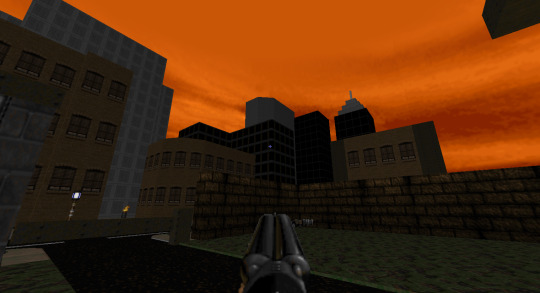

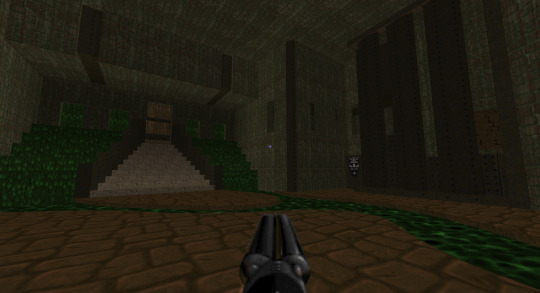
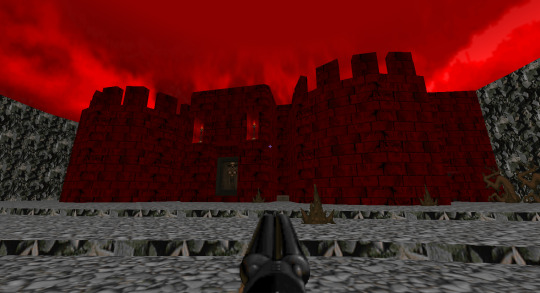
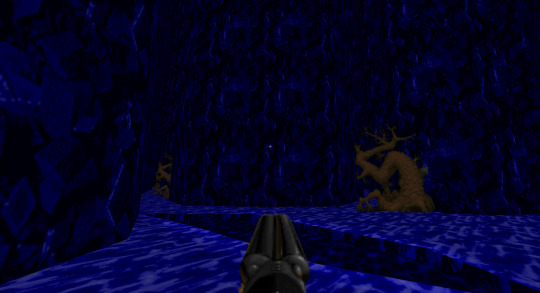
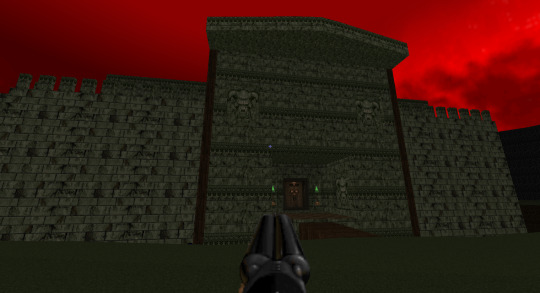
My favorite looking map (probably like with many other people) is Misri Halek, partially because it is an Egyptian map (and I’m sucker for those), and partially because it manages to combine three styles (insides of the pyramid, red caves filled with lava, and the mountain region with a nearby lava river) and somehow make it work. Honestly the less I will talk about this map the better, or it will ruin the surprise and the shock value.
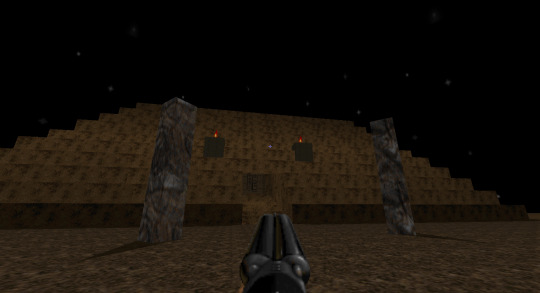
The music is also greatly matched with the maps. I’m saying matched, because almost all of the music tracks are either from the original Doom Engine games or are MIDIfied versions of music tracks from other games/media. This doesn’t mean these tracks sound bad, very far from it. They sound really good.
In terms of the tracks not related to the Doom Engine games, my favorite ones are from maps Seclusion, Beast Island (from which the track sounds like something out of B.P.R.D’s WAD), Clandestine Complex, and Fire Walk With Me. I’m not counting Rise of the Triad soundtrack because it would decimate the other tracks.
As for the only original track, Fight the Logic If You Can, well, it basically makes an already fantastic map even better. That one is my all-time favorite from this MegaWAD.

As for the how do feel when playing “Alien Vendetta” vibes in terms of gameplay, it wasn’t hard to understand the maps most of the time, even though some of them tend to be really big. There were a couple of instances where I was stuck for a few minutes the first time playing of course (hell, even when I was playing these maps again I got stuck in some moments).
The map I enjoyed playing the least was Nemesis, due to its dark and confusing caves (especially the ones where the blue key is). The fortress part was fine.
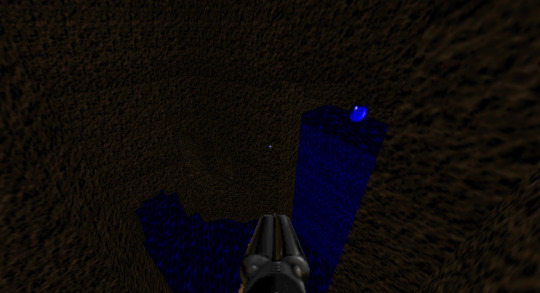
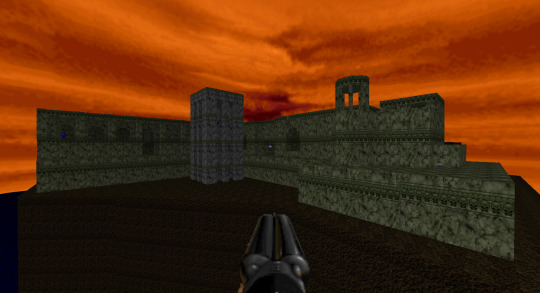
As for the other interesting stuff, Killer Colours has a very interesting concept where you go through locations colored in Blue, Green, and Red respectively, while also fighting monsters with weapons that are both connected to each of the three colors (most of the time).
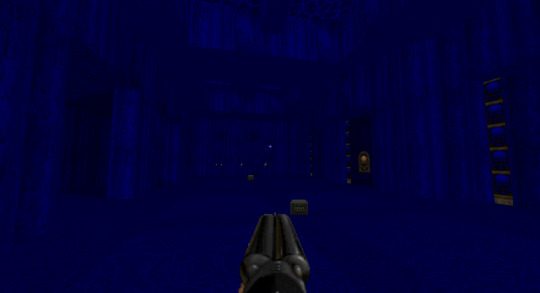

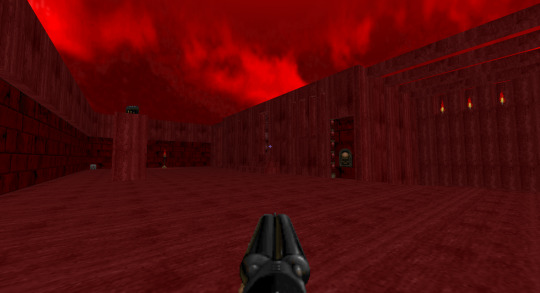
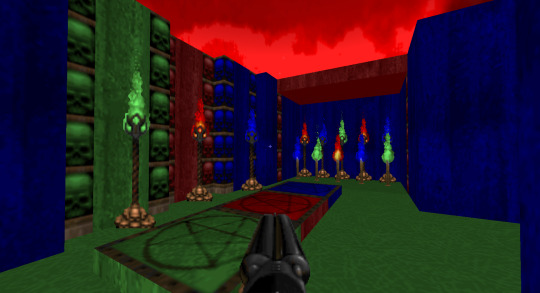
Overwhelming Odds and Lake Poison make you find three keys before going further, where in the former’s case you exit the level, and in the latter’s you end in a big arena with a shit-ton of monsters to fight.

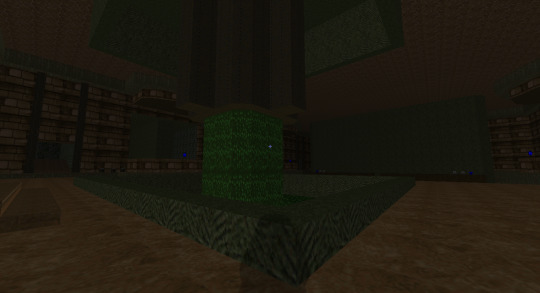
Fire Walk With Me has one section at the beginning where you have to through a very thin path before moving normally. It also has hanged imps in the second half.
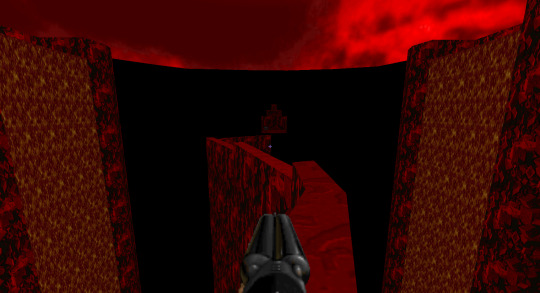

And Seclusion begins where the Cargo Depot ends, with you coming from the dark tunnel with railroads inside of it.


Now let’s change the subject to how Alien Vendetta is hard as nails.
I would like to start it out by saying that the fourth map already has over 200 enemies on it (and that’s only Hurt Me Plenty). Later levels have sometimes over twice as much. And I’m not talking about some low-tier Imps that you can mow down (although you get many of these too), I'm talking about clouds of Revenants, Cacos, Hell Nobles, Arch-Viles (at least one time from what I can remember), once you even have to fight 6 Cyberdemons at once (if you want to and thankfully there is invulnerability). Like, HOLY [[CUNGADERO]], what an absolute Hell it is!
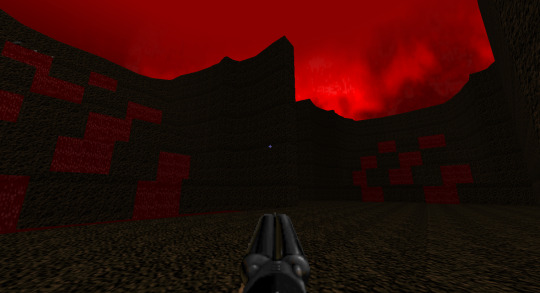
If some of you are actually thinking about marathoning Alien Vendetta, DON’T!!! Just don’t, okay?! You will be tired and sick of this WAD! Take at least a five to fifteen minutes long break after finishing a map that has at least 200 demons on it (GZDoom was counting lost souls too in my case). I believe it will help you, both physically and mentally.
Now let me tell you about the three hardest maps from this WAD (two of which were inspired by Resistance is Futile and Post Mortem from Hell Revealed) in the order they appear while playing:
No Guts No Glory might be the hardest out of this trilogy, since only in the first big arena you are surrounded by five cows and other types of demonic shit in dozens each.
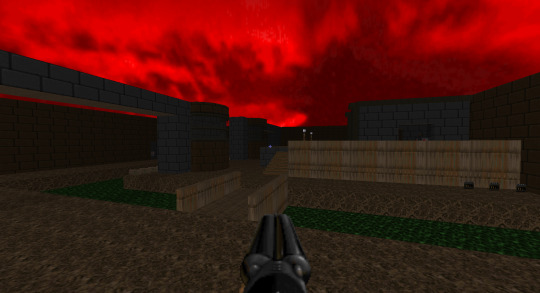
Demonic Hordes is considered to be the hardest map in this WAD and has 775 enemies on Hurt Me Plenty... But I would be lying if I didn’t say that this was the most manageable and easiest map to finish (still hard though).
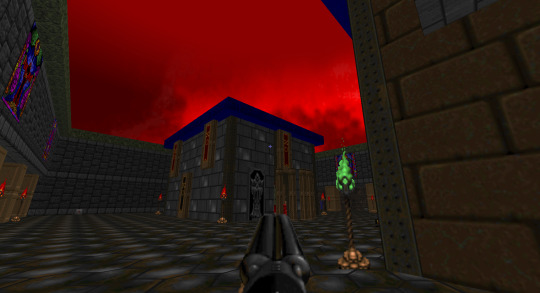
And Dark Dome has an absolutely brutal beginning. At least the other maps start out in a safe area. Other than that, I’m still questioning if this map is actually harder than the one it was inspired by.

Other levels before and after these three maps, despite their own hard moments, legitimately feel like a cakewalk compared to these circles of Hell.
The only bug I encountered during my playthroughs of this WAD was in Nemesis, where part of the water disappeared and I could see the void.

As for the bugs that I didn’t encounter but are still prominent, asides from the previously mentioned Misri Halek being too big to be played with saving in its original form without a source port, you might get stuck inside one of the secrets in Bulls on Parade. That’s basically everything I can remember.
And that’s basically all I have to say about Alien Vendetta.
Is it great? Yes.
Is it hard? Yes.
Is it perfect? Don’t make me laugh. Nothing is perfect.
Is it the best WAD of the 2000s? Honestly, I don’t know. As I said, it’s a great WAD if not tiring. I would probably have to play the rest of the standard, 30-32 maps long MegaWADs from that decade to find out if that title still holds up.
If you want to hear more about this MegaWAD have a Dean of Doom review of it (warning: it’s a bit archaic though):
youtube
And like I said earlier, do not marathon this WAD. Take a small break after finishing every longer map. Only do this if you are masochistic, especially if you are playing on Ultra-Violence.
sigh
Sometimes I feel like this WAD should be split into episodes to make myself split the review and make my life easier (to some degree).
...
Wait a minute...
You start looking at “2002 A Doom Odyssey”.
I think I might have come out with something.
See you next time.
#doom#review#Doom WAD#Doom 2#doom mod#doom 2002#2002#alien vendetta#doom alien vendetta#Doom WADs’ Roulette
0 notes
Text
Before I begin, the obligatory disclaimer: the following is a bit of a feelings dump, and it’s more personal than I meant to get, especially since I’d intended to avoid posting personal stuff here at all. When I say “please don’t reblog,” I mean “PLEASE LISTEN THIS TIME AND DON’T REBLOG.”
But there’s a lot I’m trying to process about last night’s story, the friction between narrative and game mechanics, and the emotional repercussions of this sort of scenario. It’s been a long build-up that all kind of came to a head for me last night. Ergo, this post.
To give proper context, though, I need to back up a bit to the first campaign and explain why Percy’s second death, brief as it may have been, was ultimately worse for me than the first.
—
2017 did not start well. One January day I got a call from my audibly ill father saying that both he and my mother were in the emergency room. She’d been admitted for congestive heart failure. He was diagnosed within the day with what turned out to be stage 4 colon cancer. He’d been avoiding appointments, ignoring symptoms, and putting off the inevitable, until the doctors went in only to find that the tumors had spread to the point that there was nothing they could do. I still have a clearer mental image than I’d like of my dad’s scars, along with bags and tubes hanging out because what was left of his system couldn’t do its job anymore. They stitched him back up as neatly as they could, but there was no fixing the real damage. It was done.
I didn’t have much room to breathe for quite a while. My life was pretty much consumed with trying to figure out how the hell to handle any of this. I did manage, for better or for worse, to keep carving out a little bit of time each week to watch Critical Role, because I needed something good to think about while everything else was falling apart.
Unfortunately for me, it took less than two weeks between the day all that began and the final battle with Raishan.
I was braced for possible bad outcomes, considering the severity of the fight, but what I wasn’t prepared for was for someone to get felled in a way that was basically mundane. Sure, it was a dragon that did it, so much of the situation was fantastical: an enormous mythical monster, and a swipe of larger-than-life claws. But what I had to deal with, because it was, of course, described in detail, was an evisceration. It was, to be blunt, my favorite character getting his guts ripped out. And because Pat had to go and up that ante, writer that he is, I found myself sitting numbly through a scene afterward of Kerrek beside Percy’s body, trying uselessly to put the ruined mess back together.
I still can’t think about that scene without feeling sick. I couldn’t even feel properly relieved when Percy got revived. I wanted to. Obviously I was glad that he was there for the rest of the campaign, because I wanted to see his story find a less abrupt end. I just didn’t feel any better about the idea that well, sure, he got a magic fix. It just kind of ended up spotlighting the futility of what I was staring down.
My dad died in May that year, on a Thursday night. I got home very late after hours of trying to deal with things, and found myself alone, overwhelmed and unsure what to do with myself. For lack of anything else better to do, I pulled up that night’s VOD. I couldn’t really focus on it; I kept drifting out and only sort of coming back to. I let the episode keep running for a while, though, at least wanting some friendly voices to listen to.
Then I realized what everyone was doing, and I looked at the timestamp, and I counted backwards. And I froze.
While the party was playacting at speaking with the dead, I was sitting in a hospice room listening to my father pleading with us to let him go.
I only got a few seconds further in before I stopped the video and turned away.
Despite the fact that I’ve watched almost everything Critical Role has ever done, I still have no idea how that episode ends.
—
After all this I went in for my own medical tests, since my own heretofore-handwaved-by-my-doctors health concerns suddenly seemed more pressing. It turns out, unsurprisingly, I inherited all the fun stuff. Fortunately, none of the growths were cancerous yet, because at least my unfortunate genetic legacy is something that, with proper screenings and care, it’s possible to stay ahead of. But I was told they’d need me to come in in another six months, and probably every year after that forever — or until something finally goes nuclear, whichever comes first.
Guess we’ll see.
My shorter term problems were enough to deal with on their own. The day after the test, I found out I was losing my health insurance. Two days later I found out I was losing my job. Everything since has basically been trying to patch things together from scraps. Sometimes things are sort of okay. Sometimes it’s a bottomless pit of uncertainty. Obviously, nothing in the wider world has exactly improved since, either. In sum total: fun times, especially considering I was already struggling with severe anxiety before all this began.
I wasn’t really sure how to emotionally process the ratcheting stakes in Critical Role at that point either. When you’re still watching the show because you need a breather from months of continual crisis, but your beloved characters are facing down things like, oh, a dread god and the very real possibility of everything going straight to hell, it’s…not exactly something you can turn to for relief, per se. I kept on going, because the bright spots were still so good, but I can’t exactly say I was enjoying myself for significant parts of the run, either. It was also where I started to feel a very real frustration with D&D and the inherent capriciousness that can creep in.
In short, I desperately, desperately did not want this battle to go wrong. I didn’t want to have to face a story that I’d become so invested in going completely south not because it necessarily made narrative sense, but because the dice (as they always have the opportunity to do) said “fuck you.” Yes, the feeling was probably more selfish on my part than anything else. But I still hope it’s understandable for emotional reasons, and it also got me thinking again about the entire logic of “that’s just how the game works,” and how far you can run with that before you finally trip and hurt yourself.
I’ve always had problems with a few common things in game design. One of them — usually less of a problem when we’re talking about high-level D&D, although it can still surprise you — is when things arbitrarily become harder in the game than they would be in real life. (Floor/jumping puzzles in video games where you can’t step diagonally For Reasons, I’m looking at you.) Another is any kind of gameplay mechanic that robs you of your turn or otherwise puts you out of play. Varying degrees of success or failure is one thing, but I could never understand what’s ever fun about being stopped from participating in the thing you’ve come to do. Still, one way or another, there are so many ways for that to happen. Failed dice rolls, getting stunned or disabled, outright death: there are so, so many ways.
And it’s one thing if that’s happening during the course of, say, an everyday board game, but it feels different if it starts changing the course of a full-blown story.
Part of this is the editor in me talking (who will have words with me about this post, I’m sure), because she has Opinions about it all. She always wants to keep the story on track, not go off on useless tangents, and not drop things without getting proper resolution. She’s big on structure and pacing, suspicious of too much chaos. She does not get along well with D&D. This isn’t to say that this forms the entirety of my opinion, mind; I can still appreciate the way the game works, and the fact that so many interesting and unexpected things can be born entirely because of the random element, improvisation, and decisions you have to make in the moment. But dropped threads, unfinished plots, interrupted ideas, the things that get lost, or the characters that do…those can end up haunting me.
Honestly, and this is probably always going to be a fundamental disconnect between me and any D&D game: I’ve discovered both through watching CR and playing the game a bit myself that I don’t really care about the game as much of anything except as a skeleton for storytelling. If it supports the narrative, if it gives structure, if it enables activities, if it provides opportunities for play, I’m all for it. If it yanks the rug out from under you just because, again, the dice decided to say “fuck you,” or the rules get weird, or there’s something else that just doesn’t mesh between player and scenario and/or DM, I have a harder time with it.
And it’s crushing when stories I care about collapse or turn sour because the game says so, and for reasons that feel almost cruelly arbitrary — particularly when I’m getting more than enough of that in real life.
So for CR, the ending of campaign 1 was an exercise in protracted anxiety. I was in a space where I needed something to work out, but even the entertainment I’d been turning to was becoming dangerously precarious. Wasn’t the best feeling.
In the end, luckily, it ended about as well as it could have: not without consequence, but without everything crashing down. I felt relieved, and satisfied, and glad we got a chance for resolution with the characters we’d been following for months. If anyone had to permadie, the character who was already bound to the goddess of death was not a shocker, and in many ways it’s the kindest choice; he got more resolution than any human being in the real world ever will. It barely even registered as a sad ending. I envied him, really.
I’ve watched far worse go down.
Meanwhlie, i was also thinking that even though it would be tough to say goodbye to these characters, it could also be a refreshing reset. We’d get new characters needing to find out who they are, what they want, what they’re good at, how to relate to each other, how to begin. Smaller stories, with not everything having to be about the END OF THE WORLD (again). Lower stakes. I was fine with the idea of lower stakes for a while, and less threat of impending death and pain.
Well. Like I said. It was an idea.
That brings me around to Molly, and to story decisions and gameplay decisions that both broke my heart seven ways from goddamn Sunday.
—
It took me a while to come at this part, because it took some time for the thought to crystallize that I wasn’t only reacting to the rolls of the dice in last night’s scenario. That was part of it, absolutely. Luck is a thing, strategies work or don’t, fate is capricious. I wish that several things had played out very differently, and I’m especially upset that the way things fell out, it stopped a story in its tracks that had barely even started. (I’ll come back to that.) So the start of the thought was still game vs. narrative, and it’s part of why I wrote that whole run-up you just read.
That said, the more I poked at it, the more I got upset that we were playing out a scenario like this at all.
I was thinking aloud about this in another post, but to preface it a bit better: There’s an entire meta level to three players being gone last night that everyone knew about. I understand the impulse to avoid metagaming, but it also creates some odd situations, like everyone trying (and failing, because — yep — the dice said “fuck you”) to investigate the area and find out why their friends were gone. So we had to start with a big, clunky process of the characters figuring out what the audience and the cast already knew: that Matt had written Jester, Fjord, and Yasha out by having them get kidnapped. The story is streamlined enough. The gameplay around it, not so much.
But here’s what I got hung up on once it all sunk in: why did this have to be the story in the first place?
I’m not thrilled with how a situation that arose in real life because of pretty much the prototypical joyous event (i.e. a new baby) and something that had been mundane on the show until now (Ashley being away) got turned into a brutal story about a triple kidnapping and trafficking, which promptly resulted in a death. And it says a lot about the underlying plot they’re dealing with, which is not something I’m sure I’m willing to ride with much further. I’ve been leery for a while – starting off with mutterings about an evil god only a few episodes in put me on edge from the start – and then there’s the political unrest and the religious conflicts and people disappearing…it’s all going somewhere really unpleasant really fast.
It’s also derailed a story I wanted, which hurts like hell.
We’d barely even gotten to know Molly. Molly had barely even gotten to know Molly. We got tantalizing hints, and plenty of suggestions that there was more to discover — probably an entire character arc’s worth of material. And then…this. My inner editor? Yeah, she’s screaming with frustration. In any traditionally structured narrative, this would not have happened, because even if a death was in the cards, ether it would have been timed differently so that you could get further down the road with him, or if the character was always meant to die early, any decent edit would have trimmed out most of the details that suggested at things that never got payoff. But it’s D&D, and so it’s the push-pull at work: game vs. story, plus a(n un)healthy dose of “unavoidable meta circumstances vs. the apparent need for A: drama and B: to barrel right ahead into a crisis even though there were other choices that could have been made in the light of said meta circumstances.” And…here we are.
Here we are, with a dead character who should not, let’s be honest, be dead, and a story left hanging, and far fewer obvious options for fixing it than we had at any such crisis point in the previous campaign, and lots of miserable, hurt people.
One of them being me.
—
There’s a reason this shit hurts. Personally speaking, it would hurt even if I didn’t have over a year’s worth of unfortunate circumstances making narrative swerves like this even harder to take. It hurts because the story and the characters are so engaging, because they’re worth the investment, and, yes, because when things go wrong, sometimes they’re for reasons that make me want to flip a goddamn table. And yes, maybe it’s silly to get worked up when they might — might — be able to do something about it. But we can’t count on it, and so yes. It hurts. It hurts to have a source of joy becoming something else, especially when there were so many other options. It hurts to watch favorite characters get hurt and killed, yet still be expected to write it all off as “that’s just how the game works!”, as if having emotions about it is a weakness and to be scorned.
Honestly, I found myself screaming “FUCK THE GAME” aloud last night (and probably upsetting the neighbors), which sums my feelings up succinctly enough that I should have started right there. :\
But…again, here we are, and here I am, struggling with feeling hurt and sad and exhausted with so many things veering toward pain again when I was hoping for something different, and writing big long word-vomits of posts about it.
Because D&D.
(Memo to Editor Brain: I’m tired, and I’m not going to give you another three hours to edit this post into something more manageable, so you will just have to cope. Not everything or everyone gets good endings anyway. Apparently.)
14 notes
·
View notes
Text
Editorial - Mobile Fishing
It may have been said before, and it will more than likely be said even more in the future, but a significant amount of mobile games tend to rely on a pay-to-win strategy: the more (hopefully disposable) income you shell out, the more likely you are to be a top-tier player. You may have heard the term whale before: a term used by mobile game executives in reference to those with high levels of disposable income, meant to be taken as a target for a game’s higher-prices purchasing options that range up to $100. I guarantee you that any game with a leaderboard that has in-game purchases has players that spent money on the game in the top ten. That isn’t to say that in many cases you can’t find high-tier players that don’t spend a dime, they certainly exist. But many games encourage players to spend money, and far too frequently.
From a personal standpoint, one such game for me was King of Thieves. The game itself has incredibly gameplay, very responsive one-touch controls, and a unique mechanic. As the name implies, you’re a thief, and your goal is to sneak into other players’ dungeons and steal gems from their totems to take them for yourself. You tap to jump, and you can jump off of walls to run in the opposite direction as you were running previously. Here’s the catch, from point A to point B: Gems are worth certain amounts of points, and your total points equal your overall score. You have a severely limited space for Gems, so you need to free up space to steal more gems. This leads to the purpose of your totem: by placing Gems into the totem, you can combine them together after a “ritual” that takes about about 12 hours... so long as nobody steals from your totem. Fortunately, you have the ability to rearrange your dungeon and its traps in any way you see fit, so long as you can complete it yourself, two times in a row. At this point, everything is balanced, fair, and skill-based.
Then you get to the Jewels, the premium currency. By spending Jewels, you can get better traps for your dungeon, and even spend an instant $2 to end a ritual right away. There are also special sets you can get, including items to assist you, more Jewels, a subscription service that gets you a small amount of Jewels a day, and more. Finally, each totem has a limited number of times you can use it for a ritual, so you’re eventually forced to “move out” and go to another dungeon, spending currencies to get traps for that one. I stopped playing a couple years ago, so I can’t say if there were improvements made to balance out things, but I honestly doubt it, sadly. If I’m wrong, I will be more than willing to eat crow by updating this article at a later date, but for now, I’m going to steer clear of that game.
I’m bringing this up, because I’m getting the feeling that I’m falling for the same tactics in another game, called Cookie Run: OvenBreak. This game is a unique runner in the sense that you can have a group of up to 20 cookies and their respective pets run across different prearranged levels. You can spend in-game currency of Coins to level up each cookie when you get multiple “cookie pieces” to increase their stamina, or the points they earn from collecting Jellies while running. You can also collect materials to make a Magic Candy for some, giving them an additional ability to take into effect during a run, such as additional items appearing on the field that are worth many more points.
Once again, there are special bundles allowing you to get limited cookies for a small price, subscriptions for daily Premium Currency, and higher-priced bundles allow you to get incredibly rare Legendary cookies as well. As an experiment, I purchased a bundle to see what would happen, and I saw instant improvement in terms of my high score.
Before I continue, I would like to state that in terms of either Cookie Run, or King of Thieves, it’s not the gameplay I’m complaining about, both games are incredibly fun as is, without the purchasing nonsense. The issue I have is how they advertise their bundles and specials at a very frequent basis, moreso than I personally prefer. And at this point, I think I may need to play Devil’s Advocate and note a significant difference between King of Thieves and Cookie Run: Since I’ve started playing Cookie Run, I’ve had a near-constant positive feedback loop for the game: I felt like that, regardless of purchasing anything, I would still improve as long as I kept playing and practicing. The tone overall was light-hearted, and save for the advertising of the current special after you move past the title screen each time you load the game, it is essentially pressure free.
However, for King of Thieves, since the introduction of the PvP options after you progress through the game’s story mode, I’ve been under the impression constantly that unless I spend money, I won’t get a better score than at least one other player in each ranked group of players I competed with, simply because they spent money on the game. I don’t get that feeling in Cookie Run, thankfully. That said, I’ve only played Cookie Run for about ten days now, and regarding the previous purchase, I felt comfortable contributing to a game I think is fun. I didn’t think King of Thieves was fun anymore because I kept feeling like I was being shaken down for lunch money by a high school bully, so I stopped buying and stopped playing. Once again, the gameplay for both games is phenomenal, and well worth an in-game purchase or two. But if the game keeps on encouraging purchases to that kind of extent, I’m worried about the priorities of the developers shifting to sharply toward profit over entertainment.
Fortunately, Cookie Run has a very unique way of addressing this: there are special bundles designed to reward you as you progress: the more you progress in the game, the more you earn, whether it’s playing through the unique levels in Memories Mode, or achieving a certain player level overall. That sort of thing I can see being a fair reflection of time and money: I’ve spent long enough playing this game to get this far, so by purchasing this bundle, I can get bonus items and premium currency as an additional reward, as well as helping to fund the game I spent so much time playing.
I”m not entirely sure if I really have a point to this editorial, I’ve just had this on my mind recently, so I wanted to get it out there. I suppose you can consider it a cautionary tale of sorts to be careful what you spend your money on in regards to mobile games: they’re practically the modern equivalent of arcades, except without as much of a guarantee of game quality. With any hope, I’ll be able to write better reviews of mobile games in the future to better inform you of the choices available.
#mcranter#mcranterreviews#cookierun#cookie run#king of theives#kingoftheives#cookie run oven break#cookierun ovenbreak#crob#writing#editorial#mobile games
4 notes
·
View notes
Text
Halo Infinite Multiplayer May Have Saved the Game
https://ift.tt/eA8V8J
It hasn’t been an easy journey for Halo Infinite. A disastrous campaign reveal last July that turned the game into a punchline on social media, a delayed launch, and high-profile departures behind the scenes at developer 343 Industries have been the headlines that have plagued the title for the past year, an incredibly tumultuous period that seemed to kill the hype for Xbox’s biggest release of 2021. To gamers who already felt burnt out on the franchise after the divisive Halo 5: Guardians, it seemed unlikely that this latest sequel would revitalize their excitement for the 20-year-old shooter series.
But all 343 needed to change the conversation was to put the game in players’ hands. A technical preview held from July 29 to Aug. 2 finally allowed fans (including this writer) to jump into Halo Infinite‘s multiplayer and get a feel for 343’s take on a faster Halo PvP experience that also hearkens back to the franchise’s roots as one of the foremost competitive console shooters. Despite offering only a snippet of the final product — three maps, a handful of weapons, and the first 20 tiers of a Battle Pass — the preview seems to have been a success, with many players immediately asking for more when the demo closed down on Monday.
The thought that the game that brought us “Craig” memes, and lots of whispers about its troubled development, would ever leave people asking for more seemed like wishful thinking a year ago, but 12 months is an eternity in the gaming world and 24-hour news cycle, and now Halo Infinite‘s fortunes seem to have changed (at least on social media) on the strength of the impressive tech preview.
Me now that the Tech Preview is over. #HaloInfinite #HaloInfiniteMP pic.twitter.com/zN8JBfNFBJ
— HCS Now (@HCS_Now) August 3, 2021
cnx.cmd.push(function() { cnx({ playerId: "106e33c0-3911-473c-b599-b1426db57530", }).render("0270c398a82f44f49c23c16122516796"); });
I put several hours into the preview myself, trying out the new maps — the entry-level Live Fire, the more vertical Recharge, and the action-packed Bazaar — and facing off against the surprisingly competent AI bot enemies with a team of three other players. My biggest takeaway is that matches feel much faster and kinetic, as you charge, slide, jump, or swing around the arenas, unleashing grenades and clips of the new MA40 Assault Rifle onto your enemies. Sprint, a controversial feature to some veteran Halo fans who feel the tweak to player movement robs the experience of a more classic feel, is back in Halo Infinite, upping the pace of matches to what one should expect from a modern shooter but not quite as high-speed as Call of Duty. It felt like a nice balance to me. Jumping felt suitably floaty, though, which should delight purists.
Opponents remain spongy in the classic Halo way, forcing you to use a combination of tactics in every encounter — jumping around the map while tossing grenades at the other team during a firefight feels as good as ever — a nice departure from the twitch Call of Duty gameplay that has largely become the norm of the genre. Like the best Halo games, Infinite still encourages you to get into players’ faces to land the killing blow, which proves to be incredibly hectic when in the tighter corners of Recharge or Live Fire. Weapons, grenades, and melee remain at the center of the Halo experience, with only the latter leaving some room for improvement. The melee mechanic felt sluggish or downright unresponsive at time. When landing that final elbow to your opponent’s head means the difference between life or death, that’s no good.
But that’s what the technical preview is for, and player feedback will hopefully help 343 iron out the kinks, especially with some of the weapons. While the Assault Rifle and the MK50 Sidekick pistol (a new version of the series’ classic magnum) felt like a winning loadout most of the time, the new Pulse Carbine and VK78 Commando rifle — both best at mid-range — packed less of a punch. One standout was the Skewer, a one-shot killing machine that impales your enemies as long as you time the shot just right. In fact, some may end up calling this launcher overpowered, but at least it spawns after a cooldown, which means the playing field won’t be full of them during the match. And what else can I say about my beloved Needler except that it’s still so very good to charge into battle with it like an absolute badass.
My favorite of the three maps was Bazaar, an Earth-set map that will delight Halo 2 players with fond memories of the New Mombasa sections. While teams start at the opposite side of the map, all lanes lead to the map’s central market, where you’ll have to fight over the high ground as well as the power-ups and weapons scattered in the area. While you’ll be able to snatch up Drop Walls — new deployable cover that will remind you of Halo 3‘s Bubble Shield, minus the 360-degree protection — almost from the start on the match, you’ll have to wait to get your hands on spawning Overshields and active camo, which trigger a cooldown after each use. And when they spawn, you’ll have to rush to snatch them up before the enemy team does.
One piece of equipment you’ll definitely want to get your hands on is the brand-new Grappleshot, the grappling hook first teased in last year’s gameplay demo. It is perhaps the biggest game changer to the multiplayer experience, as you can use the Grappleshot to quickly swing around a map like the multi-level Recharge and surprise your enemies from above, or simply to pick up weapons from a distance. Players bothered by how sprinting changes the pacing of Halo may also have a few complaints about the Grappleshot, although I found it added another plenty of interesting options to the way you attack, especially once you learn how to launch yourself at your opponents by grappling onto them.
Just how easy it’ll be to ambush skilled player-controlled enemies with the Grappleshot remains to be seen but don’t dismiss the bot AI, either. These bots are impressive, intelligent enough to flank you or chase you down a lane, and adapt incredibly well to each situation, switching between grenades and melee in a remarkably organic way. They also became more savage as the weekend went on, with 343 turning up the bot difficulty a bit each day. By Sunday, these bots were actually winning matches. There was also a short PvP Social Slayer test period on Sunday that I didn’t have a chance to participate in, but I never got bored of the PvE opponents, which is a good sign for the Brutes, Elites, and Grunts in the story campaign. If they’re as intelligent as the harder difficulty bots in this technical preview, expect a formidable challenge.
For the first time since last July, I’m actually excited for Halo Infinite, a sentiment echoed by other fans on Twitter over the weekend, and I can’t wait to play more of the game’s free-to-play multiplayer when it launches later this fall. (Yes, “free-to-play” does mean there will be in-game purchases and Battle Passes with rewards featuring plenty of cosmetic items to customize your armor, weapons, vehicles, etc., but I didn’t spent too much time with the customization beyond checking out the shader system, which definitely feels like a downgrade from just being able to color your armor however the hell you want.)
But there’s still so much to see from the game, especially the controversial campaign mode demoed last year. While the technical preview was never about the campaign, it accidentally revealed quite a bit about the mode. Leaked story spoilers found by dataminers within the technical preview’s files have received a polarized reception at best, with some fans already writing off the plot while others are keeping a more open mind until the final product is released.
The entire Halo Infinite campaign has now leaked. I looked at the leaks. All I am going to say is: LOL
— DreamcastGuy (@DreamcastGuy) August 2, 2021
I've read the Halo Infinite leaks, very happy with the campaign, although I have some nitpicks. Obviously it isn't the full experience, so I will reserve judgement for launch.
— Ibibo (@DatIbby) July 31, 2021
not spoiling anything, but if the leaks are true, Halo Infinite's campaign should be at most $50.
— Solar the Halo Alf (@flip_solar) August 3, 2021
There has been campaign leaks that were data mined from the pre-release multi-player and they say it's really good. Halo infinite, it's story doesn't have to be perfect, but it just has to be good. Enough to bring in new fans, and bring back old ones back into the fold.
— Solomon Orenstein (@Sorenstein901) July 31, 2021
Are story spoilers enough to really tank the game after such an excellent showing last weekend? Remember that The Last of Us Part II, arguably the biggest release of the PlayStation 4 era, had its entire story leaked a month before its eventual launch, and it still became the third best-selling PlayStation game of all time, discourse about the story notwithstanding. Like with the multiplayer, the best way to judge Halo Infinite‘s story will be to play it for yourself.
Halo Infinite multiplayer will launch as a free-to-play experience that anyone can jump into regardless of whether they’ve bought the full package containing the campaign, so the PvP won’t really live or die by its campaign, no matter its quality. Ultimately, the campaign is a discussion for another day, and judging solely what I’ve played of the game’s multiplayer, I think there’s finally plenty to be excited about in this new chapter of Halo.
Halo Infinite is coming to Xbox Series X/S, Xbox One, PC, and Xbox Game Pass later this year.
The post Halo Infinite Multiplayer May Have Saved the Game appeared first on Den of Geek.
from Den of Geek https://ift.tt/3ls8ph3
0 notes
Text
Married at First Sight - Day 15
NOTE: It seems that around this time the cooking bug was fixed… or at least improved, meaning that sims were not just constantly cooking and complaining they were hungry. As such the extent to which I was actively meddling in that aspect of the gameplay greatly reduced.
It was a quiet morning at the apartments, with nothing noteworthy happening before Venkat and Riley set out for their visit to the Shalvoy family.
Family Visit - The Shalvoy Family

Location: Base Game Modern mansion by fr0905
Arriving at Venkat’s family home in Willow Creek, he and Riley were in the mood for fun. They wasted no time in turning up the stereo, and whilst Venkat’s sister Peyton was unmoved by their invitation to dance she was also entirely unsurprised.
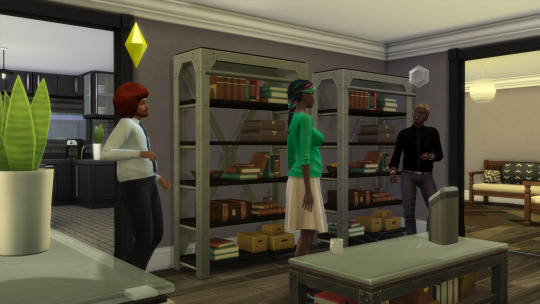
Taking a quick coffee break, Venkat sat down with his brother Dale to bring him up to speed on how things were going with him and Riley. Three-quarters of the way through the competition Venkat is glad to have been matched with Riley and cannot imagine having a better time with anyone, but that chemistry seems to be purely platonic, which somewhat defeats the object. Dale thinks that Venkat is over-thinking things.

NOTE: I kinda want to make a spin-off focusing solely on Dale - he seems like a… character.
At length Riley and Peyton joined them, and they all settled down to watch Chateau du Landgraab. Dale exclaimed that this was his favourite movie, and fortunately the others had seen it enough times to not be bothered by Dale’s running commentary.

After the movie Venkat’s father Colten appeared. Everyone else decided to give him and Riley some space to get to know each other, which may not have been the best move as Colten was soon interrogating Riley over his family background and career progress. Nothing Riley said seemed to please him…
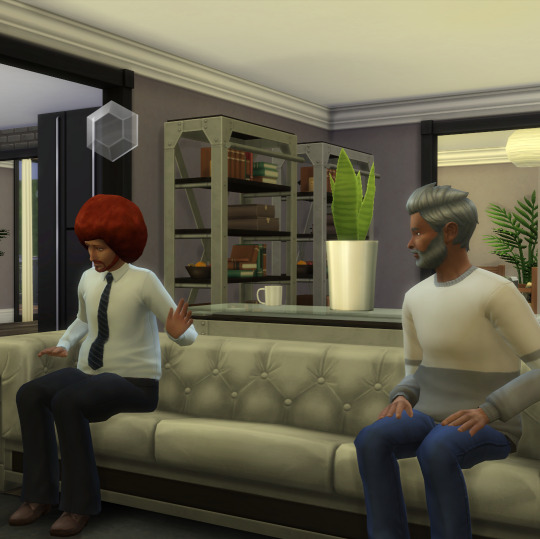
Dale and Peyton soon returned to rescue Riley, and Peyton had Dale and Riley in hysterics with her colourful anecdotes, whilst a glowering Colten stomped off in search of Venkat.

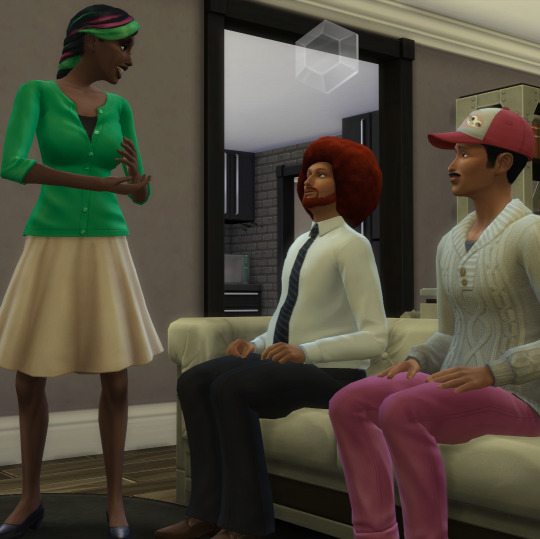
Colten found his son upstairs on the computer, and much to his disappointment Venkat had no time for his father’s negativity, explaining that even if there was no romantic spark between himself and Riley he was still a very good friend.

Back downstairs Venkat’s mother Cherish had returned home and seemed to take a far more amicable view of Riley.

Before long Cherish was telling Riley enthusiastically about several embarrassing moments from Venkat’s childhood, which Riley was sure to file away to tease Venkat over later!
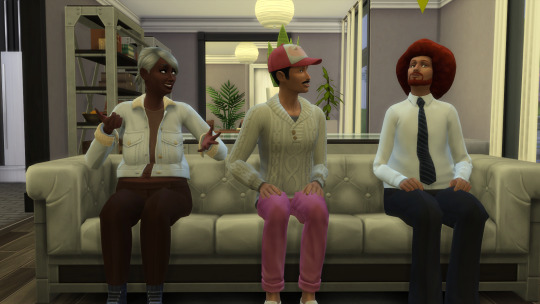
Peyton went to find out where Venkat and her father had got to. She found them crowded around the computer with Venkat’s other brother Cohen watching work-out videos and debating the merits of different techniques.
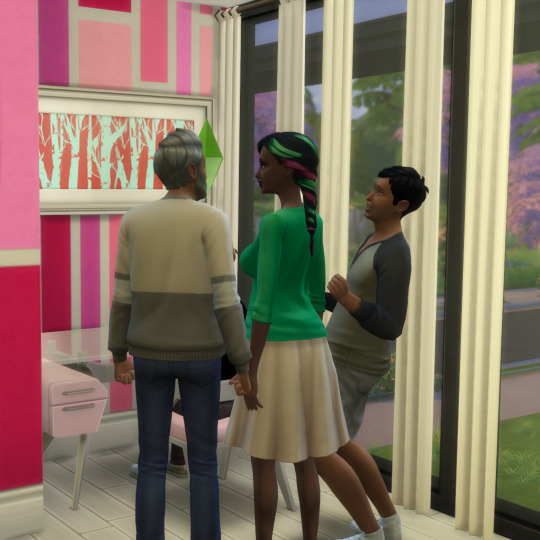
As the visit came to an end Venkat said his goodbyes to his family. Taking his brother by the hand, Dale reminded Venkat to just relax and stop overthinking everything.

Back at the apartments…
Riley told Lauryn and Julian all about his day with the Shalvoy family, and how everyone had been really nice except for Colten (and Cohen, who he had barely seen). Lauryn explained to Riley that there were aspects of his personality that other people would find aggravating but that he should not care about their opinions…
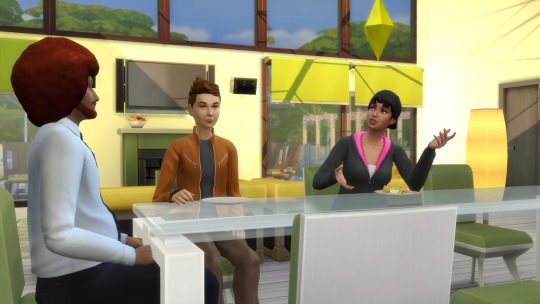
This did not have the reassuring effect she had hoped.
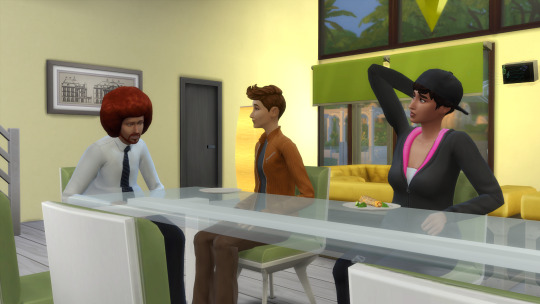
As the evening went on several of the contestants gathered in one of the apartments to eat, chat and dance, and all the women appeared to be getting on well.
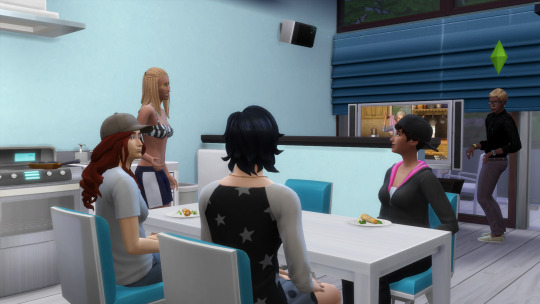
Lauryn and Julian decided that they needed some time on their own away from the other contestants so took a late-night trip to the park, where Julian amused Lauryn with tales of strange creatures lurking in the dark.
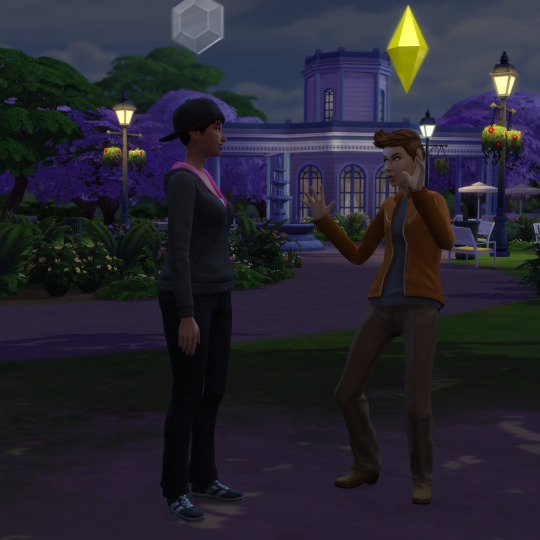
After this they headed to the museum and compared ideas for decorating their ideal home.
Once they got back, Chensey caught up with Lauryn and made it clear she had forgiven her for her remarks about Venkat’s dancing the previous week, wrapping her up in a reassuring hug.

Lauryn also managed to make up with Riley by expressing her admiration for his culinary prowess. Riley was happy to accept the extended olive branch and the two of them stayed up late so Riley could provide Lauryn with advice as she prepared a meal for the following day.
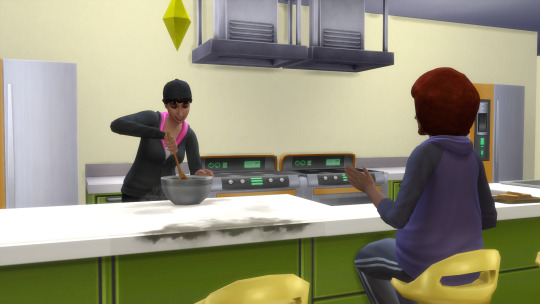
NOTE: By this point in my gameplay I had gone from finding Lauryn kinda boring to her actually being my favourite. She means well, but just seems to have a knack for saying the wrong thing at the wrong time…
Click here to go to Day 16
0 notes